Quality of the Environment in Japan 1993
4-1-5 Measures for Protection of Pristine Nature and Wildlife
Pristine nature is not something from which incomes may be directly gained, but its public benefits are high from a viewpoint of maintaining it as places for the people to have communion with it. Nonetheless, there still is the need for a further enhancement of efforts for the realization of such public benefits.
(1) Systems for Protection of Pristine Nature and Wildlife
The people are taking a high interest in the protection of pristine nature and wildlife. In the opinion poll taken by the Prime Minister's Office in fiscal 1991, 36.1% of the respondents described the protection of nature as "the most important thing for man's life," 58.5% suggested it should be "promoted while working for a harmony with man's soci- ety." Only O.7% regarded it as "unnecessary as it impedes development, among other things." When the responses are compared with those of the poll taken in 1986, the rate of respondents describing the protection of nature as "the most important thing for man's life" increased from 28. 5% to 36.1%, whereas that of respondents with a suggestion that it should be promoted in harmony with man's society decreased from 63. 3% to 58.5%. Those responses suggest that the number of persons who consider the protection of nature important is on the rise along with their consciousness.
As regards measures for the protection of pristine ecosystems and wildlife in Japan, institutional measures are under way, such as controls on acts in designated areas, regulatory measures on capture and collection, controls on transactions and export-import controls, in accordance with the Natural Environment Conservation Law, the Natural Park Law, the Law Concerning Conservation of Endangered Fauna and Flora Species and the Law Concerning Protection and Hunting of Birds and Wildlife, among other laws (Fig. 4-1-16). Efforts are also being made for the protection of forests under a system of reserved forests under the Forest Law.
Fig. 4-1-16 Excellent System for Protection of Nature and Wildlife
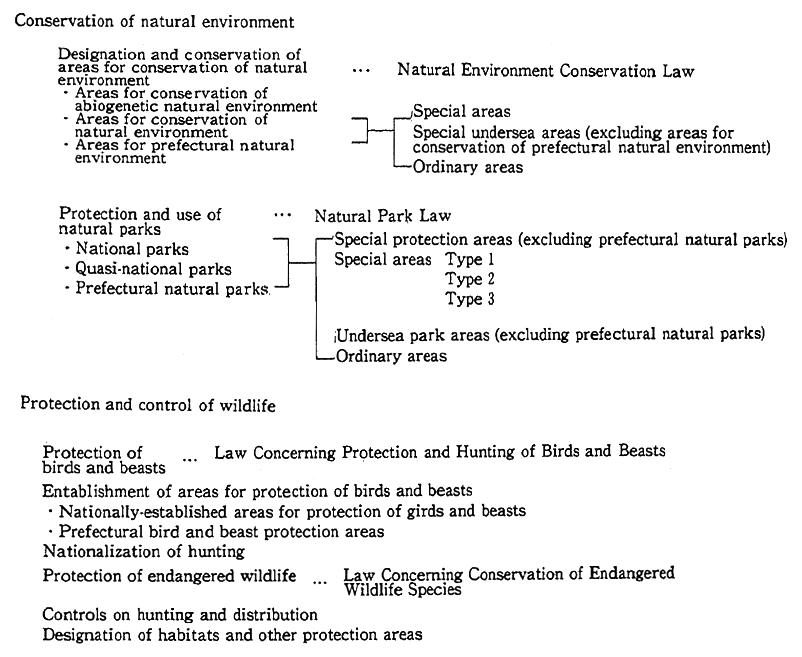
Source:Prepared by the Environment Agency
For the protection of pristine nature and wildlife, it pays to protect individual elements of nature and wildlife and to conserve the well-arranged habitats and breeding places, while paying attention to the conservation of ecosystems. With this in mind, area-oriented protec- tion measures are taken through the designation of areas. When it comes to pristine nature, protection measures have been taken for the natural environment and natural parks, among others. The areas thus designated account for 14.34% of the total area of the national land (with areas for protection of the natural environment at 0.23% and natural parks at 14.11%). Protection is being done under the systems of reserved forests in the national forests, protection forests and natural monuments, among others, and those based on the decrees of local governments. As regards the protection of wildlife, a bird and wildlife protection system is in force under the Bird and Wildlife Protection Law. When it comes to endangered wild fauna and flora, systematic protection measures are being taken under the Law Concerning Conser- vation of Endangered Wild Fauna and Flora enacted on April 1, 1993. In plain language, the endangered domestic species are designed as "rare domestic species of fauna and flora," and capture, sales, exports and imports, among other things, are controlled. Besides, habitats and other places are protected by designating protection areas, such as habitats. Moreover, it is decided to carry out projects for protection and propaga- tion, if necessary. Under the Law Concerning Controls on the Sales of Endangered Wild Fauna and Flora and the Law Concerning Controls on Sales, Etc. of Unusual Birds, the species enumerated in Annex I to the Washington Convention under which sales and so forth are controlled and bilateral migratory bird treaties are designated as "internationally rare wild fauna and flora species," and measures for controls on sales, exports and imports are being taken (Fig. 4-1-17).
Fig. 4-1-17 Ovtline of Law Concerning Conservation of Endangered Wildlife Species
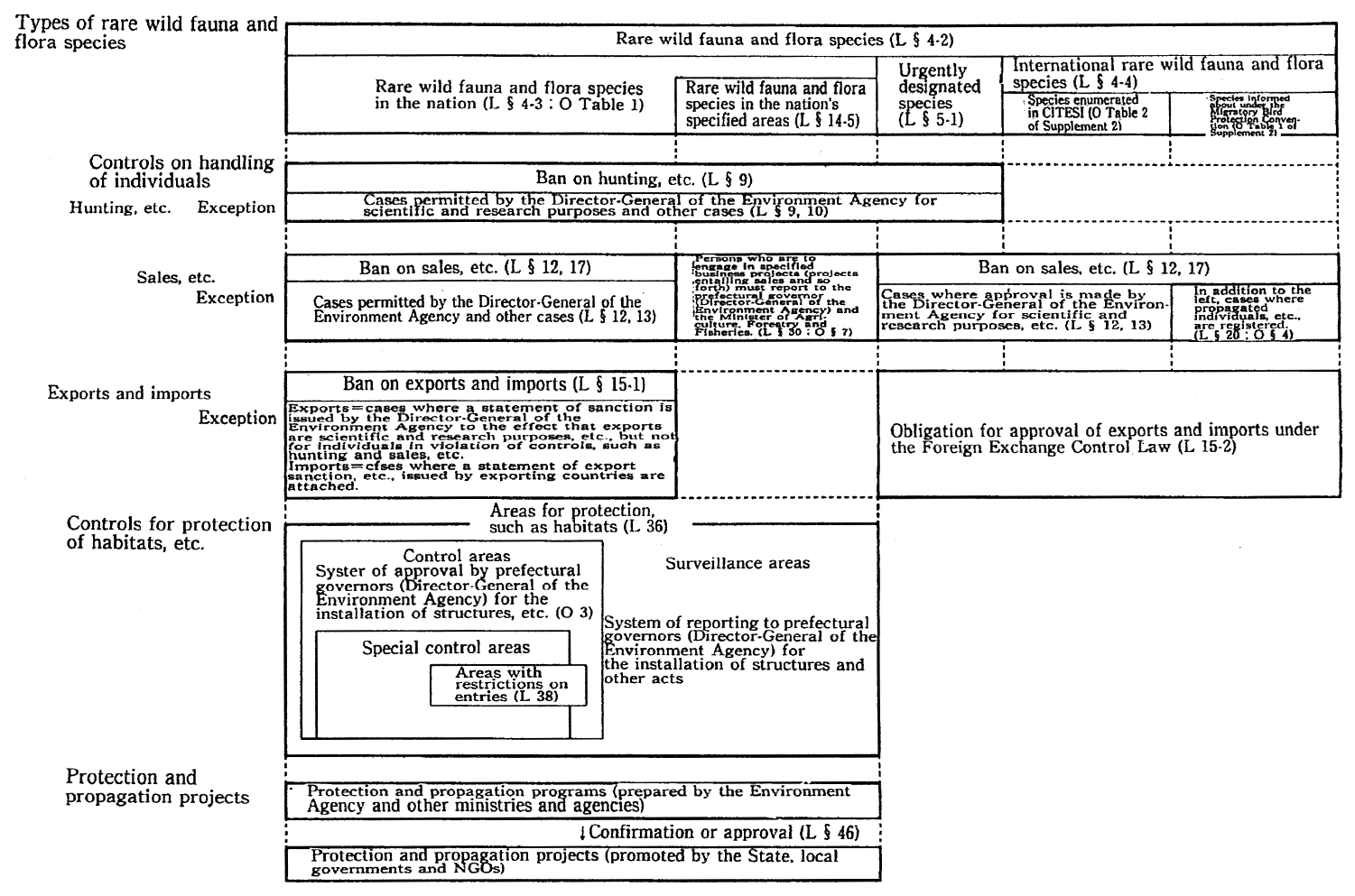
Notes:
L: Law Concerning Conservation of Endangered Wild Fauna and Flora Species
O: Ordinance for Enforcement of Law Concerning Endangered Wild Fauna and Flora Species
Source; Prepared by the Environment Agency
(2) Sharing of Roles for Promotion of Protection--Present State and Problems
Thus, the protection of pristine nature and wildlife leads the people to realize the necessity, and the protection system is being streamlined. On the other hand, the protection of pristine nature and wildlife tends to conflict with. community residents' interests.
When it comes to highly natural areas and the areas inhabited by wild animals, such as bears and antelopes, many of them are located in the mountainous, peninsular and insular areas, as we have seen in Section 2, Chapter 1. In those areas, on the other hand, the degree to which agriculture and forestry turn out to be occupations is significant. Moreover, they are also areas where depopulation is in. progress. Coordination with those activities is posed as a task in promoting tangible protection measures.
Let us think about this problem with the damage done by wild animals on saplings and farm produce as an example. A case in point is "Cranes and Their Fly-in Areas in Kagoshima Prefecture" which is designated as one of the State's natural monuments and a State- established bird and wild animal protection area. As protective mea- sures have been carried out for many years, the number of fly-in cranes had come close to 10,000 by 1990. But damage was caused by increasing migrant cranes in this area, and it has yet to be stopped though measures carried out by related municipalities. Fly-in migratory birds have increased in recent years, and there are cases in which fly-in areas are concentrated in specific districts, raising concern about the damage to agriculture, forestry and fisheries by the concentration of migratory birds. Damage is also caused by wild animals. For example, antelopes cause damage in some districts, such as by eating sprouts, and in an effort to regulate the population, 1,000 antelopes or so are captured a year under an agreement with the Environment Agency, Agency for Cultural Affairs and Forestry Agency. In fiscal 1990, damage was caused by birds and wild animals on farm produce in 249,000 hectares of land and on forestry in 7,500 hectares of forests (Table 4-1-5).
Table 4-1-5 Trends in Damage to Crops by Birds and Beasts (National)
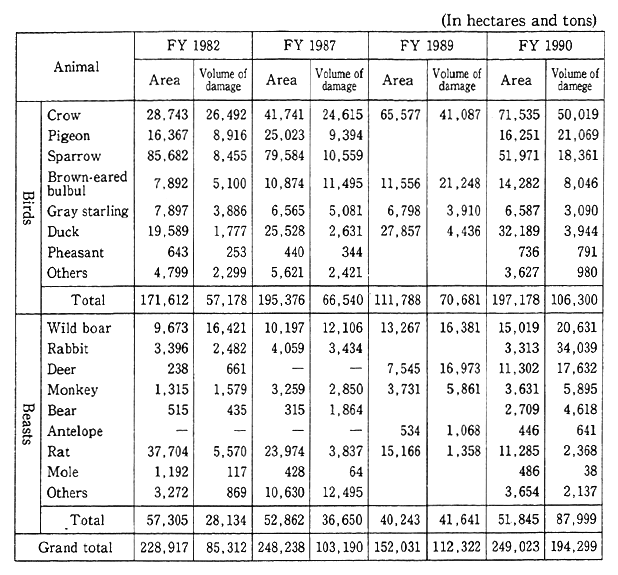
Notes :1. Prepared according to data from the Ministry of Agriculture, Forestry and Fisheries.
2. "-" in FY 1982 and FY 1987 is included in "Others."
3. For FY 1989, damage to those other than 9 species in not tabulated.
Source: Administrative Surveillance Bureau, Management and Coordination Agency, Present Status and Problems of Measures to Protect Endangered Wild Fauna and Flora
In order to cope with such damage, the development and research of more effective measures for prevention, such as by installing fences for protection and by regulating certain destructive migratory bird populations. Coordination of individuals in charge of controlling the appropriate numbers of birds and wild animals is also conducted. Inci- dentally, it is difficult to come to accurate grips with actual wildlife populations as things now stand. There are calls for examining the conditions of habitation and, on this basis, to manage wildlife popula- tions in a more scientific manner.
Beside the damage inflicted by wildlife on agriculture and for- estry, the designation of protection areas is also something which calls for coordination. The administrative surveillance conducted by the Management and Coordination Agency on the Present State and Prob- lems of Measures for Protection of Endangered Wild Fauna and Flora in 1992, the designation of protection areas is not necessarily welcomed because of controls on development and subsequent drops in land price. For example, areas for conservation of the primitive natural environ- ment, areas for conservation of the natural environment and areas for conservation of the natural environment by prefectures have hardly increased in terms of area [Fig. 4-1-18: In July 1992 after the administra- tive surveillance, the Shirokamiyama Natural Environment Conserva- tion Area (14,043 hectares) was added]. As for prefectural natural environment conservation areas, no designation has been made for three prefectures and there has been no additional designation for 21 prefec- tures since the first half of the 1975-84 period. It was pointed out that there were a number of areas which prefectures had planned to desig- nate as prefectural natural environment conservation areas but did not materialize due a failure to secure agreement from relevant persons, The natural parks include strictly controlled special protection areas, and it was pointed out that there existed conditions in which an area expansion and a strengthening of the controls could not be done as their designation would take a long time.
Fig. 4-1-18 Trends in Area of Natural-Environment Conservation Areas, Etc.
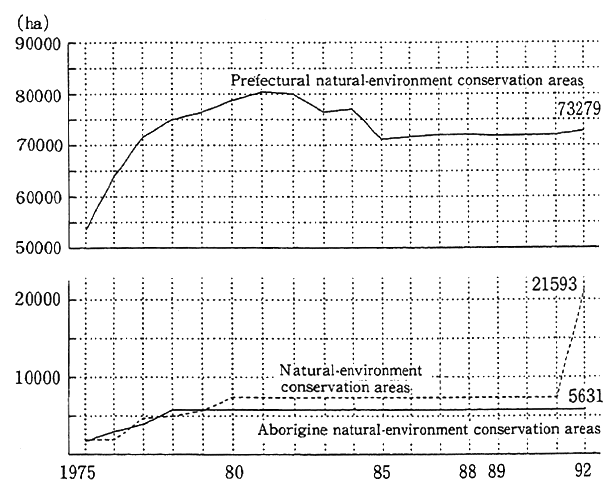
Source: Surveyed by the Environment Agency
The protection of wildlife and pristine nature is recognized as important for the present generation whose responsibility it is to protect it for the next generation. However, measures for the protection of wildlife often interfere with development brought on community resi- dents, such as falling land prices. Particularly in Japan, protected lands include many privately owned ones, so that it has become a serious problem to mediate such conflicting interests when the burdens for protection are concentrated on residents in depopulated communities and so forth. The aforementioned opinion poll suggests that general public opinion about the protection of nature is somewhat different from that of agriculturists (Table 4-1-6).
Table 4-1-6 Consciousnoss About Natural Enviroment
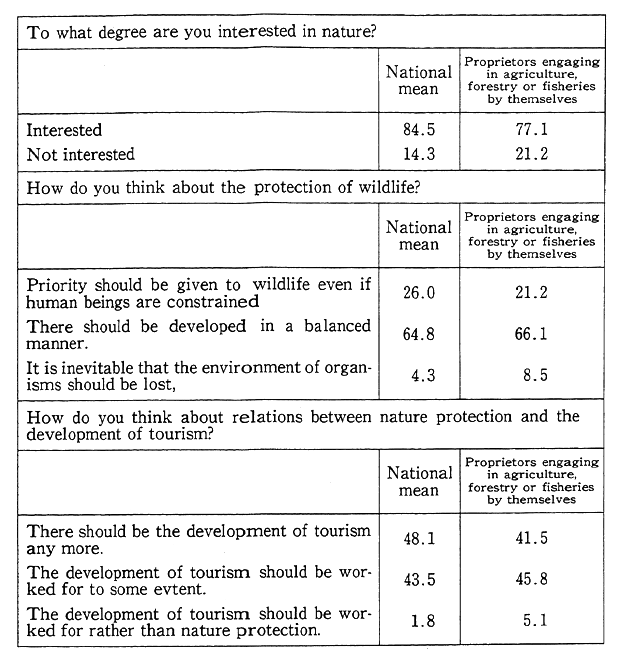
Source: Prime Minister's Office's Public Information Office, Opinion Poll on the Protection and Utilization of Nature (June 1991 survey)
Let us see the degrees to which measures are actually taken for the protection of wildlife and nature. Fig. 4-1-19 illustrates the State's budget for the protection of nature and the per capita expenditure. The per capita expenditure stands at ¥1,300 a year. Fig. 4-1-20 indicates the number of local government officials in charge of the protection of nature, which accounts for only one-fourth or so of the officials in charge of environmental protection. The situation is such that there is a gap between calls for an enhancement of nature protection measures and appeals for resolving of the conflicting interests about the protec- tion of nature, on the one hand, and the systems with which administra- tive authorities ought to come out.
Fig. 4-1-19 Trends in Rate of Natural Environmentrelated Budget to National Budget and in Natural Environment-related Budget per person
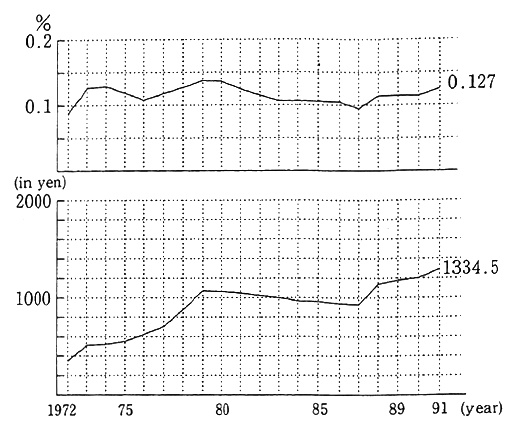
Note: The natural environment-related budget per person is expressed in terms of 1991 prices.
Source: Surveyed by the Environment Agency
Fig. 4-1-20 Trends in Number of Officials for Administration of Nature Protection in Prefectures and Administrative Ordinance-Designated Cities
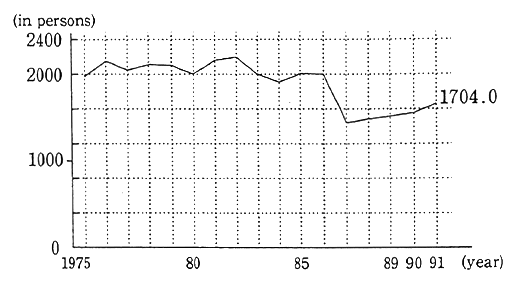
Note: As for officials with extra assignments, decimal fractions come oat as computation is made with the portion dedicated to administration on nature protection taken into account.
Source: Surveyed by the Environment Agency
On the other hand, areas with abundant wildlife and affluent nature are troubled by depopulation and other factors, so that it is impossible to respond to burdens for the protection of wildlife and nature. According to a survey of the National Land Agency, municipal- ities in what known as the "intermediate mountains" are confronted with depopulation and aging, and it is pointed out that the vitality of communities is going down and the management of upland fields and forests is hampered. It is also pointed out that one of the reasons for the damage from wildlife is that the vitality of communities is so much diminished that there is no surplus manpower for damage prevention. For example, the number of licensed hunters, which serve to keep wildlife populations in check has dropped in recent years and their aging is in progress, and the situation has appeared where competent hunters may not be readily secured even if the culling of populations is required.
(3) Efforts for More Reasonable Sharing of Responsibilities for Protection of Pristine Nature and Diverse Wildlife
Attempts are being made for the sharing of responsibilities for the protection of the pristine natural environment and diverse wildlife.
The ecosystems of many developed European nations are not so rich as in Japan, and the protection of wildlife is dealt with in the form of protection of traditional farming methods. In efficient farming methods, it is disadvantage ous to leave hedges and grass gathering areas as they are. But from a perspective of conserving ecosystems and protecting wildlife, among others, it has come to light that those hedges and grass gathering places are of importance. For example, Great Britain began for this reason a system of environmental sensitive areas (ESA) in 1987,under which farming families in designated areas could have access to grants-in-aid, beside counsel from nature protection specialists and so forth, when they would carry on traditional farming methods advantageous to the habitation of wildlife. In 1987, nine areas were designated and the number had been increased to 10 by 1989 with an aggregate area of 740,000 hectares. The system might be described as an attempt for the people as a whole to partly share the cost for farming families who have to bear a cost in the form of wildlife protection.
Many cases may be observed where an attempt is made to use nature and wildlife as a lever to vitalize the community without impair- ing them. "Eco-tourism" is a typical example, and it may be considered one of the methods for a revival of the community by giving life to the community's culture in which its nature is integrated. Culture which takes root in it and the community's nature is something of which people in the community are proud and which is an invaluable resource. It is important to regain the vitality of the community without losing the pride and resources.
For community residents' efforts to bear fruit, it is necessary for the people in general to respond to them. For example, as the people place a high value on nature by visiting places with rich nature on a vacation and commune with nature in a manner that nature will not be impaired, it may be anticipated that it will become easy to introduce that kind of community vitalization measures.
There is also the need to carry on studies on methods for commu- nion with nature and those to work for a balance between protection and utilization, and it is also necessary to modify them, depending on the community's features. For the development and propagation of those methods, the cooperation of NGOs, not only community residents, is important. There are cases in foreign countries where NGOs are devel- oping activities for propagation and protection and those designed to work for the separate habitation or coexistence of man and wildlife, and such attempts have also started in Japan.
The degree of familiarity with the natural environment and wildlife in mountain and farming villages is highest for residents in those communities, and they have to date taken charge of the protection of wildlife in the kind of life in which they coexist with wildlife and the natural environment. Their culture has also been closely tied in with wildlife and the natural environment. On the other hand, the people have come to highly value the protection of pristine nature and wildlife. In the Bill for the Basic Environmental Law submitted to the Diet in March 1992, the sustainable enjoyment of environmental blessings and the maintenance of ecosystems and biodiversity are taken up. Given the fact that such ideals are expressly defined as a standard, there is the need for community residents and the people in general to reasonably and fairly share the role.
4-1-6 Conservation of Natural Environment in Major Urban Spheres Including Greens and Living Creatures
Nature in major urban spheres, including greens and living crea- tures, constitutes part of the natural environment of the national land whose proximity to residents plays an important role in their lives. In Japan's major urban spheres, nature is being rapidly lost. In Tokyo, Osaka and other major urban spheres with an ongoing concentration of population and economic activities, housing development in the suburbs and the development of golf links in the peripheries, is giving rise to a depletion of wildlife. In terms of the entire national land, those major urban spheres have turned out to be areas with less nature due to a rise in human activities.
Let us take the National Capital Region as an example in check- ing to see how greens are being lost. Fig. 4-1-21 presents an analysis of changes in the land cover for 18 years from 1972 with the use of satellite images. In this figure, urbanized areas, areas devoid of forests and reclaimed areas are taken up and illustrated. The figure suggests that the depletion of greens is in progress in conjunction with housing development in the suburbs of existing built-up urban areas and areas within a radius of 20-40 km from the center of Tokyo. In the southwest- ern direction from the center, urbanization in association with the development of Tama New Town and Kohoku New Town and in eastern direction, the depletion of forests in conjunction with the devel- opment of Chiba New Town are observed. In the loop 40-60 km from the center, on the other hand, forests are depleted due to urbanization and the development of golf links, among other things. The transformation of forests is observed in Chiba Prefecture and in the west of Saitama Prefecture.
After quantitatively analyzing changes in the land cover of the National Capital Region with the use of the Numerical Information About the National Land, Table 4-1-7 presents changes over 13 years in the form of a matrix before and after the changes. Though it is required to pay attention to the itemizing method which is different from the aforementioned image data provided by the satellite, the matrix sug- gests that the degree to which forests, land under cultivation and barren land, among others, is significant, and that the degree to which forests are converted into barren and other lands is also great. The former is urbanization in conjunction with the development of housing areas and so forth, whereas the latter represents changes in forests by the develop- ment of golf links. In those 13 years, 4.1% of forests were converted into barren and other lands and 3.0% into urban areas. Besides, 7.1% of farmland was converted into urban areas. Depleted forests and farm- lands totaled 525 km2, equivalent to Tokyo's 23 special wards.
In the following, let us take a general look at an important role nature in major urban spheres ought to play and the direction in which efforts are made for nature conservation.
Table 4-1-7 Matrix of Changes in Land Cover of National Capital Region (1976-89)
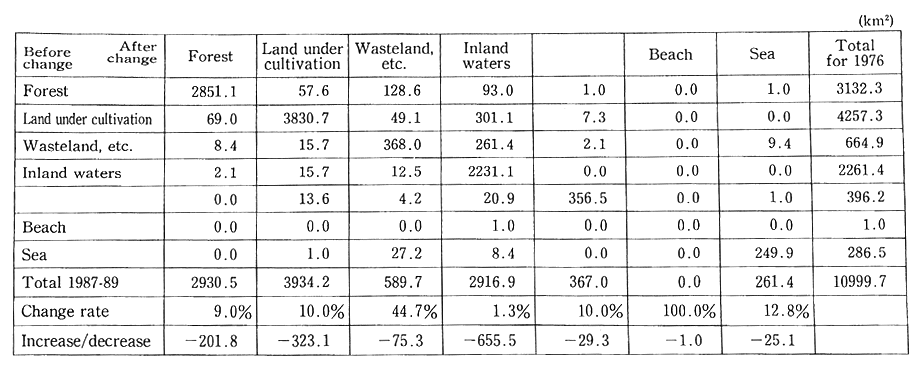
Notes: 1. The table indicates land cover changes from land cover in the left.hand column to land cover in the upper row.
2. Values in three-dimensional meshes for areas within a radius of 60 km from Tokyo
3. Data after the revision are shown as those for the 1987-1989 period as the Numerical Information on the National Land were streamlined from 1987 to 1989.
4. The classification of land varies from that which is used for the Numerical Information on the National Land. "Land under cultivation" represents "paddy fields," "upland fields," "orchards" and "other fields planted with trees" in the Numerical Information on the National Land, "wasteland, etc." represents "wasteland" and "land for other uses," and "built-up urban areas" represents "land for building" and "land for trunk transport."
Source : Prepared by the Environment Agency on the basis of the Numerical Information on the National Land
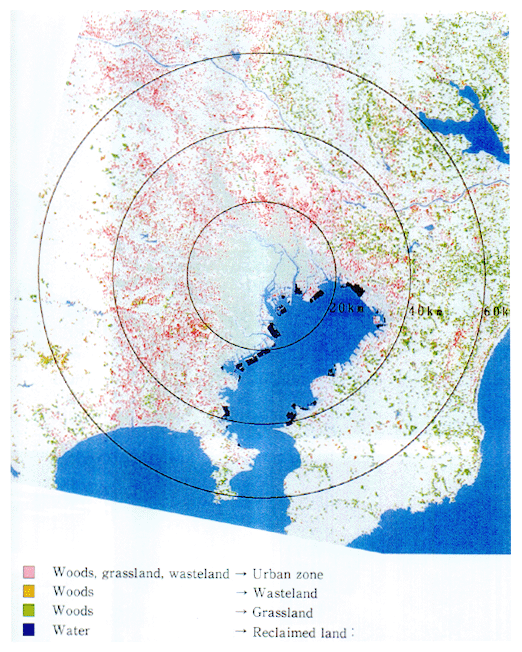
Note : This is an extraction from the maps on the next paper of changes in the land cover of major urban spheres in 1972 and 1980.
Source: This diagram was produced by the Tokai University Information Technoloby Center, based on the Environment Agency's "Survey on Land Use Changes in Metropolitan Areas."
Fig. 4-1-21 Changes in Land Use in the Tokyo Metropolitan Area (1972-1990)
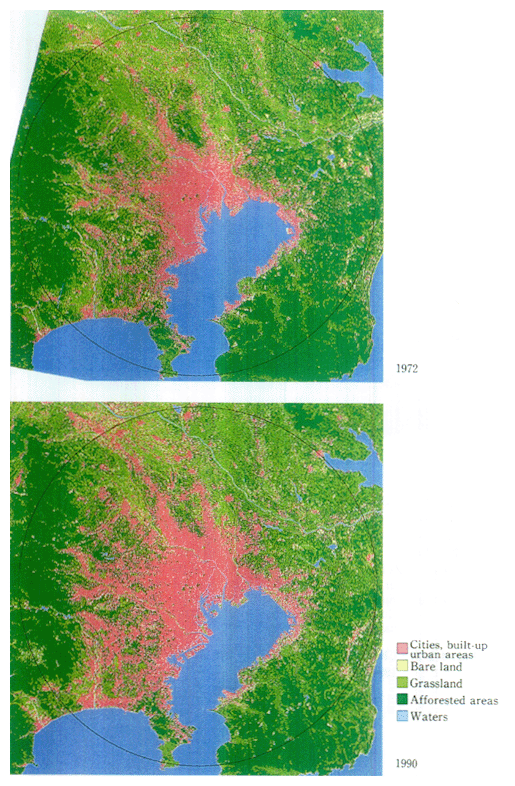
Source:This diagram was produced by the Tokai University Information Technoloby Center, based on the Environment Agency's "Survey on Land Use Changes in Metropolitan Areas."
Stuffed sea turtles smuggled but confiscated by customs officials
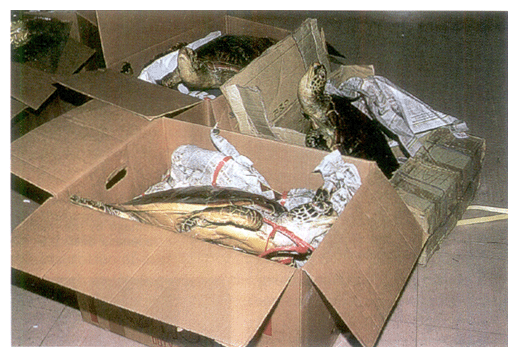
A scene from The Earth Summit in Brazil in June 1992
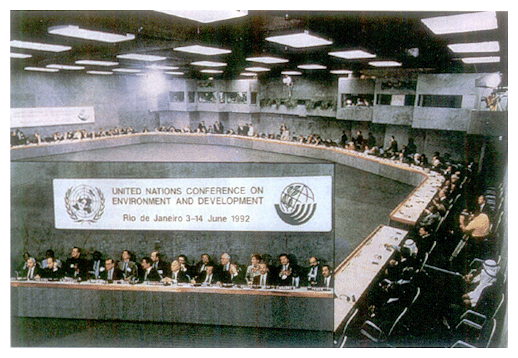
Damage by the nibbling of Japanese deer
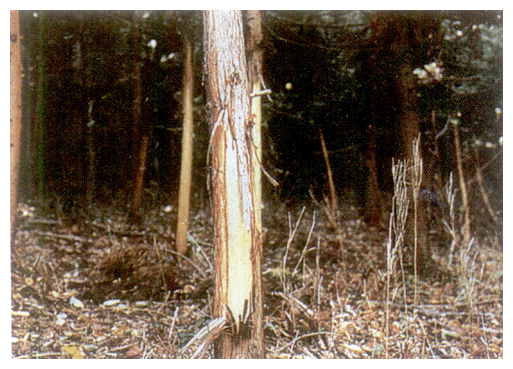
Forest control work in the Pantabangan Forestry Development Protect
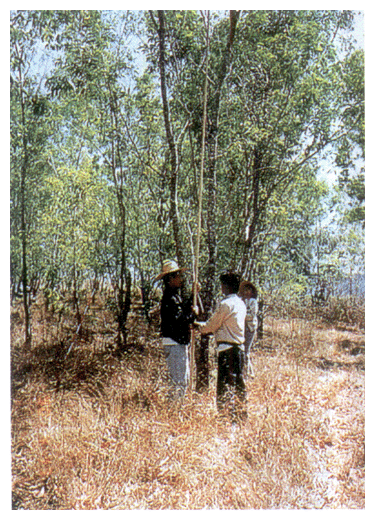
Sewer treatment facilities for a Japanese business (Indonesia)
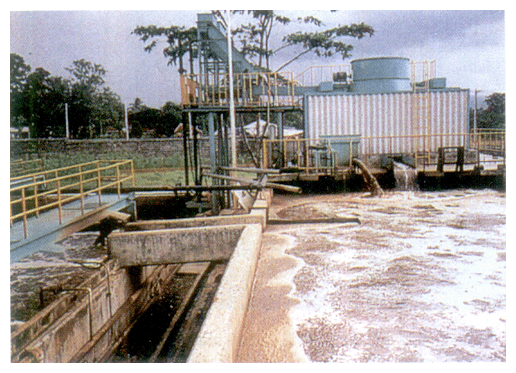
(1) Importance of Natural Ecosystems in Major Urban Spheres
a. Utility of Nature in Major Urban Areas
As we have just seen, greens and other close-by places of nature have been lost in major urban areas. Let us see in a number of perspec- tives just what role such nature can play.
First, it has been known to date that the functions of greens in urban areas are useful in various ways. The functions include develop- ing groundwater, river and other water sources; that of preventing land slides and other natural disasters; that of purifying the atmosphere, such as the adsorption of dust; that of alleviating noise; that of mitigating the climate, such as the lowering of the ground surface temperature; that of forming a comfortable living environment; and that of outdoor recrea- tion grounds, among others.
When it comes to the function of alleviating the climate, for example, it is known that the increase of urban greens leads to a mitigation of the heat island phenomenon and a drop in the temperature. Therefore, energy demand for air-cooling systems may be dropped and carbon dioxide emissions curbed. It is also known that plants them- selves are able to absorb carbon dioxide and other pollutants.
For formation of a comfortable environment, greens are of utmost importance. The findings of an opinion poll on the factors people considered important for formation of a comfortable environment, "affluent greens" come on top of the list with 51.5%, followed by "bracing wind" with 38.0%, suggesting that more importance is attached to natural factors than artificial ones, such as "rows of beautiful houses on the streets" and "recreation facilities."
For the maintenance of chances to come in communion with nature, the natural environment of major urban areas is also of impor- tance. The people have a growing yearning for nature, and according to an opinion poll, the respondents who wanted to increase chances to come in communion with nature accounted for 63.1% on the national average with Tokyo's rate coming to as high as 83.5%. In order to increase chances for communion with nature, it is important to conserve close-by natural environment which may be enjoyed in everyday life. According to the opinion poll, the largest number of respondents pointed to the "leaving as it is or increasing close-by nature around our houses and workshops" as a method to increase chances for communion with nature (Fig. 4-1-22).
Fig. 4-1-22 Methods to Increase Chances for Communion whth Nature (to those who answered they wanted to increase chances for communion with nature ; duplicated replies)
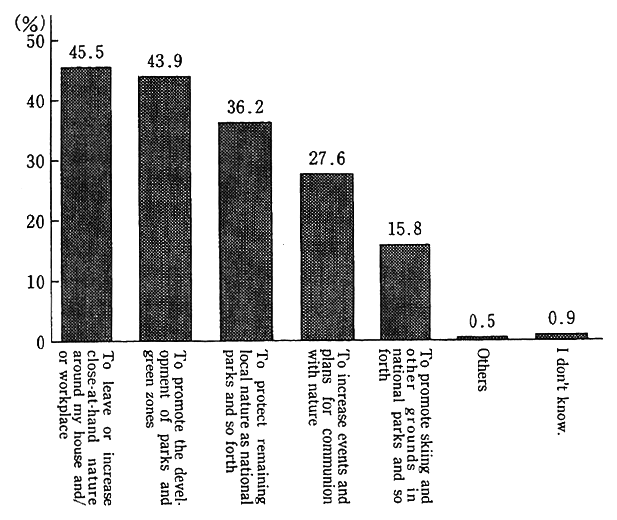
Source:Opinion Poll on Protection and Utilization of Nature(1992)
The assurance of communion with nature is something which is required not only to respond to the people's needs but in terms of nature education as well. For man's coexistence with nature, it is important for individuals to deepen their understanding about the subtle mechanisms of ecosystems, enrich their sensibility of rich nature and have closer ties with it. Nonetheless, greens are on the decrease in major urban areas, thereby reducing close-by wildlife. According to a survey of the Envi- ronment Agency, close-at-hand living creatures, such as skylarks and fireflies, are gradually disappearing from urban areas. A check of the distribution of skylarks around Tokyo shows, for example, that they were no longer observed in and around Nerima, Tanashi and Kunitachi, though they were seen in 1984 (Fig. 4-1-23). Having said that, there is concern that children are growing up with few chances for communion with living things while playing around in the realm of nature (Fig. 4-1-24). Given this picture, the increase of communion with nature is taken up in Article 13 of the Bill for the Basic Environmental Law submitted to the Diet in March 1993.
Fig. 4-1-23 Decrease of Close-at Hand Organisms in Major Urban SpHeres
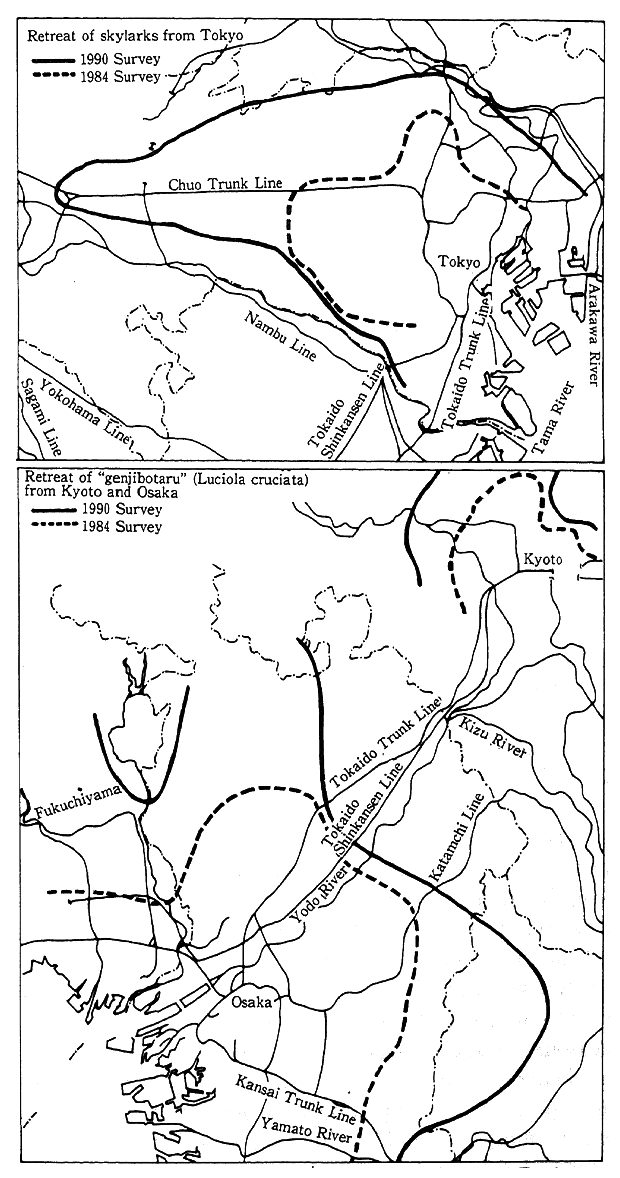
Source : Environment Agency, Basic Survey on Natural Environment
Fig. 4-1-24 Rate of Children's Experience in Playing in Nature
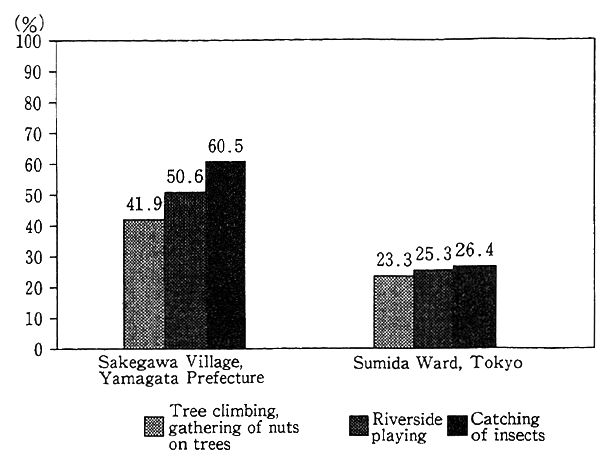
Source: National Land Agency
b. Necessity of Nature as Ecosystem
In assessing the importance of nature in major urban areas, it is necessary not only to make quantitative evaluations but to grasp nature as an ecosystem in a more comprehensive manner and think about its role from a qualitative perspective with attention paid to its individual functions. Being in a delicate balance, natural ecosystems are the basis for survival of all living things, including humankind. Today, there is a danger that the balance might be impaired by the loads of human activities on the environment. In order to check such development and hand over the environment to the future generation, it has become important to conserve the diverse natural environment in a systematic and pre-emptive manner. For this purpose, it is all the more important not only to conserve the primitive and rare natural environment but close-at-hand nature in the community.
In terms of consciousness, the people have come to seek diverse greens in alignment with nature. The findings of an opinion poll suggest that as reasons for satisfaction with "green" in the everyday life, such factors as "I cannot entertain a sense of familiarity because of excessive artificiality" and "few and monotonous kinds" are cited after "too little green" which came on top of the list (Fig. 4-1-25).
Fig. 4-1-25 Reasons for Dissatisfaction with "Green" in Everyday life
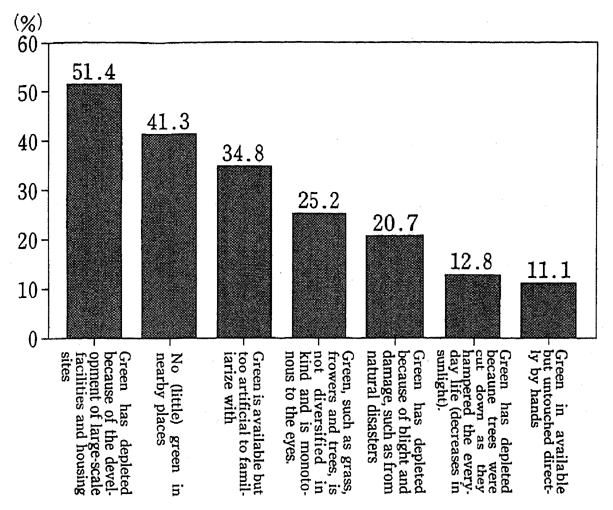
Source: Opinion Poll on Urban Greening (1991)
In major urban areas with the depletion and shortage of greens, it is important to keep the absolute acreage of greens and develop them in such a manner that residents may readily use them. Given the aforementioned conditions, there is the increasing need to attach impor- tance not just to the quantitative aspect but to the qualitative facet and maintain nature as a sound ecosystem. When it comes to the utilization of greens by residents, it has become important not only to increase chances for their use but to make communion with diverse nature possible in qualitative terms as well. In the conservation of nature, therefore, it has become important to attach importance to the sound- ness of nature and cherished species which inhabit the districts, by taking the places of wildlife's habitation and growth into account, and carry out protection and development in a state of rich diversity.
As an example of development of the natural environment with importance attached to the original ecosystems, the woods of the Meiji Shrine's courtyard may be cited. They were developed when the shrine dedicated to Emperor Meiji was constructed in 1915-20. Established in 1915, the Meiji Shrine Construction Bureau decided on an afforestation policy favoring evergreen broad-leaved which would center on indige- nous species which of. Though it was proposed by some quarters that a stand of "sugi" (Cryptomeria japonica), "hinoki" (Chemaecyparis obtusa) and other needle-leaved trees, the Construction Bureau did not agree with this proposal, as "sugi" did not fit in with the shrine's land. But, as it was difficult to transplant evergreen broad-leaved trees, the first layer was formed with Japanese black pines and the second layer with "hinoki" and sawara" (Sawara niphonica). The third layer had many evergreen broad-leaved trees, such as "sudajii"(Castanopsis cuspidata), the oak family and camphor trees, which would become predominant species in the years ahead, and the transplanted areas were left to natural transition. As a result, many black pine trees fell down, withered or sustained damage due to typhoons and so forth. However, evergreen broad-leaved trees which centered on homeland species thrived, and 25 years later, grew up to a point where they look in their external appearance like a natural forest almost all of which are evergreen broad-leaved trees. Today, though they cannot be classified as natural vegetation, but their appearance and their functions as an ecosystem look more like those of a residual natural forest (Table 4-1-8).
Table 4-1-8 Comparison of Number of Meiji Shrine's Trees by Type
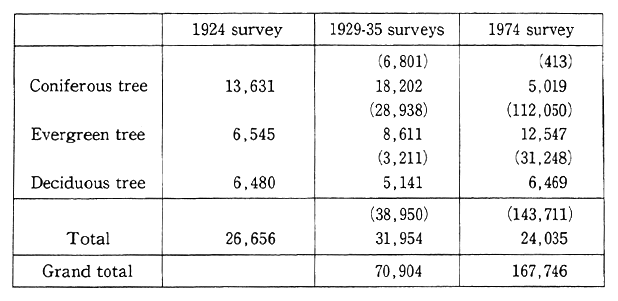
Note : The figures in parentheses are those less than 30 cm in circumference.
Source : Koshiro Ishigami, Learning from Nature
Trees grew up at such a fast pace because the land was maintained and improved, soil faunae were enriched, ecosystems were formed and the productivity of the ecosystems was given life, as fallen leaves and branches were not removed but reverted to the earth in the control of trees. In a comparison of the diversity of soil faunae with that of Hibiya Park where fallen leaves and branches are removed, identifying the number of soil animals in areas planted with camphor trees, the findings suggest that it stands at l76m3 for Hibiya Park whereas it rises about 50 times to 9.014/m3 for the Meiji Shrine. The shrine's wood thus performed various functions as part of rare preserve in Tokyo. For example, highly vital trees and soils serve to purify air pollution, and carbon dioxide concentrations in the trees are significantly lower than outside (Fig. 4-1-26). Thus, the Meiji Shrine's wood might be described as an example of the formation of an rich ecosystem, taking account of natural vegetation.
Fig. 4-1-26 Comparison of Amount of SO2 Between Peripheral Urban Areas and Urban Forests
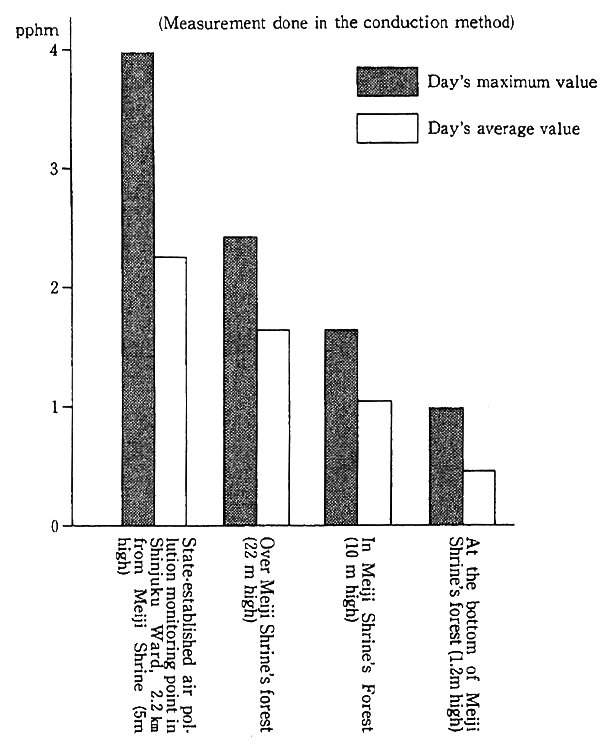
Source: Hitoshi Honda (1982), Functions for Environmental Conservation of Meiji Shrine's Forest. Kikan Kankyo Kenkyu (Quarterly Environmental Studies) No. 41
As we have just seen, conservation of nature as an ecosystem is expressly defined as a policy of measures taken up in Article 13 of the Bill for the Basic Environmental Law submitted to the Diet in March 1993.
(2) Problems Raised in Conservation of Natural Environment in Major Urban Areas
In reality, nature in major urban areas is rapidly on the decline, and it has become an important task to step up its conservation.
Therefore, the State has set up a variety of systems and is working for conservation with the cooperation of local governments. The systems of area designation and so forth associated with conserva- tion of the existing natural environment in major urban areas are diverse, as indicated in Table 4-1-9, and in order to protect and develop nature as an organic system, there is the need to make comprehensive use of those various systems.
But there are various problems that have to be overcome for nature conservation in major urban areas. Relations with land owner- ship is important as background. For conservation of the natural envi- ronment, there are many cases in which some kinds of restrictions have to be imposed on the owners of natural tracts. In Western countries, however, importance is generally attached to public interests and the limitation of private rights with restrictions on land utilization is broadly recognized without any specific compensation. In Japan, much value is generally set on the free exercise of land ownership, thus making it difficult to restrict land utilization for public interests. As for the designation of green land conservation areas, natural parks, reserved forests and so forth, a system of direct and indirect compensa- tion is instituted in conjunction with the purchase of designated plots and restrictions on it for an adjustment with private rights. In major urban areas, however, there are many more cases than in their periph- eries in which the land prices are higher and the forms of land ownership are more complicated making progress difficult.
Moreover, because conservation of the natural environment in major urban areas is different in some aspects from urgent public health issues, there are signs that compulsory restrictions are considered difficult to implement. Here, let us examine these tasks for the perspec- tive of landowners and other effected parties.
Table 4-1-9 System for Designation of Principal Areas for Conservation of Natural Environment in Major Urban Spheres
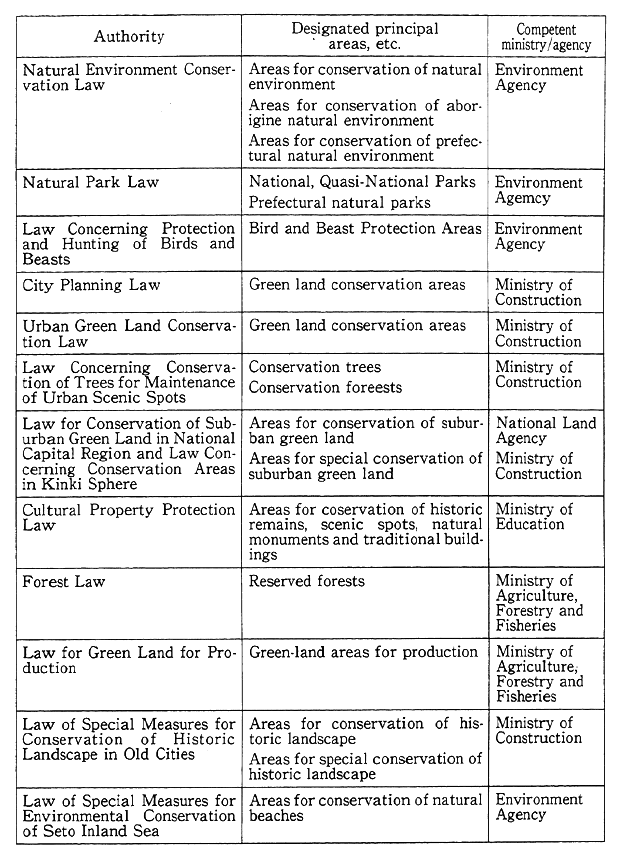
Note : As regards areas for conservation of the aborigine environment and areas for conservation of the natural environment, no such places are designated in the major urban spheres.
a. Landowners
As viewed by landowners, it becomes a problem that individuals will possibly sustain losses if the natural environment is conserved for public interests. In situations where there is a chance for the develop- ment of a private plot, for example, the profit which would have been gained will be lost. For this reason, some compensation or the other will be demanded. When some kind of area designation is to be made for nature protection, an attempt will be made to avoid it as the possibility of using the land for some different purpose is hampered thus lowering land value. Even in situations where a land owner intends to conserve the natural environment of his own land, it will sometimes be used for other purposes, such as the apportionment of bequests for succession, contrary to the wishes of the former owner. Reportedly, there are cases where trees are cut down to avoid bearing the fixed property tax on trees.
For the maintenance of the natural aspects of owned plots, on the other hand, there is the need for various controls, depending on their characteristics. Though there is room for a study on management in line with natural ecosystems, it becomes necessary in many cases to do work ranging from collecting fallen leaves and weeding, depending on the conditions of vegetation and relations with neighbors, which affect the natural ecosystems.
Thus, as viewed by landowners, it does not seem fair to them that others do not share the costs associated with conservation even though nature's blessings are enjoyed by a broad segment of peripheral resi- dents who should contribute in some form or another.
b. Residents
In the eyes of residents, there are indications that they favor nature conservation in their peripheral area but are opposed to it when it is to be done immediately around their houses. For example, they complain that if the conservation is done near their houses, the neighbor- hood will become dirty with scattered leaves, dust and, insects; the neighborhood will not get enough sunshine, and water pipes on the roof will be filled with fallen leaves. With roadside trees, they complain that shop billboards will become obstructed and that it will become difficult to get cargoes in and out of the shops. With those complaints, there are cases in which they are opposed to the conservation of greens and demand landowners and local governments to make cleaning and other controls thoroughgoing. Then there are cases in which while enjoying natural blessings of the suburbs, people do not take interest in their control and throw away trash and recklessly gather plants.
c. Local Governments
As viewed by local governments, it has become financially diffi- cult to buy and maintain land for the protection and development of nature in light of rising land prices. For this reason, they are compelled to maintain land with area designation and other methods rather than purchasing it. However, it is indispensable for landowners to understand and cooperate with restrictions for the public use of their plots. The cooperation and involvement of community residents and landowners are indispensable for the management of nature, such as roadside trees, trees remaining in cities, hills in the suburbs of villages and many other places.
Thus, for conservation of the natural environment in urban spheres, various relevant persons, such as landowners, residents and local governments have their own situations and interests, so that without mutual understanding and cooperation, it would be difficult to further promote conservation of the natural environment.
(3) Conservation of Natural Environment Done in Urban Spheres with Cooperation of Relevant Persons
It is possible to effectively conserve urban spheres' nature with persons appropriately sharing roles and cooperating with one another. Let us examine pioneering cases in foreign countries as examples.
Great Britain's Grand Work Trust Project is designed to promote improvements in the close-at-hand environment with the cooperation of administrative authorities, citizens, corporations and so forth. A grand work trust is established in each district with funds from the central and local governments, among other organizations. With the trust serving as the core, a wide variety of projects ranging from the environmental improvement of barren land and management of the natural environ- ment to the promotion of environmental education with the involvement and cooperation of various entities are being carried out. For example, factories offer plots whose use is discussed with the participation of citizens, which are developed into nature observation parks managed by volunteers. In the center, the Grand Work Trust was established by the Environment Ministry and its related institution, the Countryside Com- mission. As we have seen, private businesses also support this project with the offer of funds, materials and manpower, and tax incentives are provided to those voluntary corporate efforts. Besides, the names of corporations who have sponsored districts are posted, and various other contrivances are worked out to reward those efforts. The basic ideal of grand work trust projects is "partnership for action," and one feature is that more importance is attached to the process in which the voluntary activities and cooperative relations develop than to the mere gain of recognition.
In Germany, efforts are being made not just for the conservation of greens but for the systematic protection and restoration of places for the habitation and growth of fauna and flora in line with the concept of "biotope." For the conservation of ecosystems, living things and the environment for their habitation and growth distributed in the close-at- hand realm of nature are taken up as subjects for conservation, and the Landshaft [Scenery] Program (Fig. 4-1-27) based on the Federal Nature Protection Law, ponds and marshes, rivers, grasslands and forests, among others, are meshed into networks in areas from suburbs to city centers. In plain language, forests, farmlands and so forth with a high degree of nature in the suburbs are protected and form the core of the network. When it comes to farmlands, farm-roadside space is turned into natural grassland. In built-up urban areas, biotopes, large and small, such as city parks, afforestation areas, vacant lots and the gardens of individuals' houses are prepared with importance attached to eco- systems. As space for the movement of animals from suburban forests and farmlands to built-up urban areas, rivers and roads are defined, and the greening of river banks, routes and so forth are being promoted. Importance is attached to diverse vegetation with wild species with extensive efforts to recreate their natural state. One feature of this example in Germany is that measures are formulated from a perspec- tive of looking upon nature as a system and technology for this is developed.
Fig. 4-1-27 Basic Concept for Landscape in Former West Berlin and Basic Concept for Protection of Species
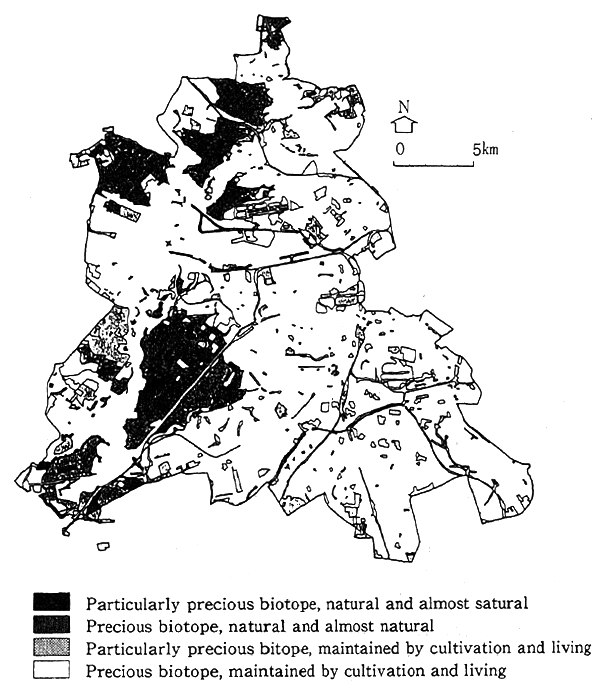
Source: Takehiko Takeuchi (1991), Regional Ecology
For conservation of such biotopes, the cooperation of various related persons is indispensable. For example, the conservation of the natural environment around farmlands is being stepped up on the basis of talks between farming families and administrative authorities, and the greening of courtyards, walls, roofs and so forth is carried out with the cooperation of citizens. In the administrative sector, it is obligatory in the Federal Nature Protection Law for related government agencies to cooperate with nature protection agencies. In line with this law, a cross-sectional promotion system of administrative agencies was, estab- lished to realize conservation of the natural environment with measures in each sector, while the departments and bureaus, which take charge of nature protection and park greens, serve as the core. Thus, cooperation by administrative authorities, citizens, farming families and other entities is promoted to step up the conservation of ecosystems in urban areas. For the protection of ecosystems which take on a cross-sectional character, the German experience teaches us that administrative mea- sures should be managed within a system made up of various measures.
As we learn from those examples, it is important to adequately conserve the close-at-hand natural environment, attaching importance to its soundness as an ecosystem and work for its systematic conserva- tion, while related persons, such as administrative authorities, residents and landowners, cooperate. The administrative sector is able to con- serve the close-at-hand natural environment and raise its utility for society with each entity striving to conserve nature, while it works for conservation of the natural environment in a systematic and comprehen- sive manner through a wide variety of administrative divisions and offers frameworks for cooperation by residents and landowners. Mean- while, residents step up voluntary greening which goes as far as to cover the courtyard and other forms of small space and involve themselves in the management of public natural areas, and landowners work for the conservation of natural areas with cooperation rendered in restrictions for public use.
To promote conservation of the close-at-hand natural environ- ment with the cooperation of various related persons will be of use, albeit indirectly, not only in conserving the close-at-hand natural envi- ronment but in checking nature depletion in major urban areas and the entire nation by means of broadly recognizing the importance of nature and the necessity of protecting it in a system of mutual cooperation.
4-1-7 Measures on Chemicals Used in the Past
Chemicals are useful for our lives, but those which are especially hazardous are likely to adversely affect the environment and human health, should they be irresponsibly handled.
When it comes to hazardous chemicals, it is extremely important to take appropriate measures so that they may not be discharged into the environment to adversely affect human health. From this perspec- tive, a de facto ban is put on production, import use and so forth of chemicals which are toxic or bioaccumulative, such as PCB used for insulation oil, DDT used as a pesticide,Bis (tributyltin) oxide used as antifoulant paint, etc.
In order to prevent environmental pollution by those hazardous chemicals and their damage to human health, it is also important to promote other environment protection measures.
Here, let us examine the past and present status of PCB (short for polychlorinated biphenyl) as an example of a chemical for which a serires of measures have been taken.
(1) PCB--Polluition and Response
PCBs are compounds made by the chlorination of biphenyl not existing in the realm of nature. PCB was widely used as it is insoluble in water, stable in organic solvents, fire resistant and low electrical conductive. Its greatest use was for the insulation oil of electrical condensers and transformers. It was also used for the thermal medium of heat exchangers and so forth and sensitized copying paper, among other things. Production began in Japan in 1954. Output reached 11,000 tons or so in 1970 but dropped to about 6,800 tons in 1971 when environ- mental pollution came to the fore. Production was suspended in 1972. By that year, about 59,000 tons had been put out in the aggregate. About 1, 100 tons had been imported during that period in the aggregate. Accord- ing to World Health Organization (WHO) data, it is projected that more than 1 million tons were produced around the world.
Because of its usefulness, PCB was broadly used. In 1966 and subsequent years, PCB was detected in fish and eagles in Sweden and various other places in the world. In Japan, too, the case of Kanemi oil symptoms in 1968 made the toxicity of PCB a grave social issue. In this incident, PCB used as a thermal medium in the edible oil production process was mingled with the edible oil, causing health damage. In 1971, PCB was detected in fish, birds, soil, sediment and water and even in human bodies, including breast milk, which became a grave issue.
In response to them the government established the council for promotion of measures against PCB pollution in 1972, which was made up of officials from related ministries and agencies, and decided to promote measures for restrictions on production and use, environmental quality standards and recovery and disposal of polluted soil and sludge. In plain language, PCB production was suspended and its recovery and so forth were ordered under the administrative guidance of related ministries and agencies. In 1973, Chemical Substances Control Low, was enacted. Under this law, PCB was designated as a Specified Chemical Substances (redesignated as Class I Specified Chemical Substances, because of the law amended in 1986), and its production and so forth were prohibited.
It was also decided to recover and store already produced PCB including products which contained it. First, it was stipulated that liquid PCB should be recovered and stored by the producers and that PCB- using electrical appliances, such as transformers for heavy electric power, and so forth, should be taken into custody ay the users. Sensit- ized copying paper containing PCB was recovered and stored by the makers and government agencies. Besides, guidance was provided so that the entrepreneurs who owned it should take it into their custody. When it came to household electrical appliances in which PCB- containing condensers were used, it was stipulated that the makers should detach the condensers and take them into their custody when local governments collected the wastes.
As regards the discharge and disposal of PCB and PCB- containing products, provisional tolerable limits to emissions and drain- age standards under the Water Pollution Prevention Law were for- mulated. When it comes to the final disposal of wastes, it is stipulated that PCB shall be incinerated or removed. As for PCB-containing sludge, it is stipulated that reclamation of a shut-off type shall be made.
As a measure to cope with environmental pollution, on the other hand, dredging and other purification projects had been completed by the end of July 1991 for 75 of 78 waters where pollution of the bottom by PCB had been detected in excess of provisional removal standards.
(2) Present State of PCB Pollution
As we have just seen, PCB production was suspended and a product recovery system was developed, and measures were taken to prevent environmental pollution in the years of 1970s. Subsequently, pollutant removal projects and the surveillance and survey of water and organisms have been under way.
Of the present aspects of PCB, let us examine its present situation in the environment. As for water, PCB was not detected from 3,823 samples oll over Japan in fiscal 1991. On the other hand, the biological monitoring of fish, shellfish and birds in a total of 20 sea regions, freshwater channels and lands, indicated that PCB was detected in the fish, shellfish and birds of 12 areas. The secular trends in a survey of sea bass in the Bay of Tokyo and the Bay of Osaka (Fig. 4-1-28) reveals that the trends have generally leveled off, though there has been fluctuations, depending on the year. Thus, PCB remains in the environment of broad areas even today.
Fig. 4-1-28 Trends in PCB Concentrations of Sea Basses in Bay of Tokyo and Bay of Osaka
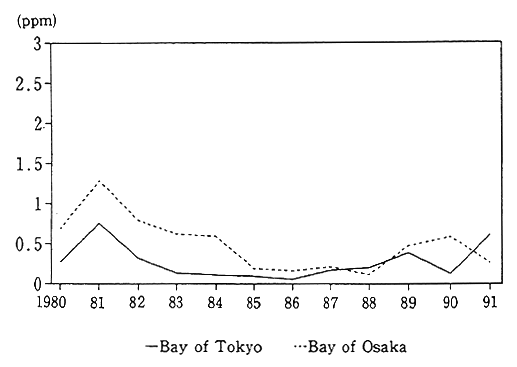
Source: Environment Agency
(3) Actual Processing of PCB and Present State of PCB Custody
A check of the custody of PCB-containing products reveals that Mitsubishi Monsanto's Yokkaichi plant, a liquid PCB producer, has about 970 tons in its custody. The 5,500 tons or so which was placed in the custody of Kanegafuchi Chemical Industry's Takasago plant was disposed of as follows. In response to calls from Hyogo Prefecture and Takasago City, the Comittee for the Study of High-Temperature Thermal Decomposition of Liquid PCB was established in the Environ- ment Agency in 1985 to study the safety of tests on the high-temperature thermal decomposition of PCB and assess the findings of the tests. While comprehensive surveillance was made under the guidance and supervision of Hyogo Prefecture from 1987 to 1989 on the basis of those findings, the high-temperature thermal decomposition was conducted by the plant. For the surveillance standards in the processing, the PCB dissolution rate was set at 99.9999%, the PCB concentration in the exhaust gas was set at downwards of 0.01mg/Nm3 and PCB in the wastewater and peripheral environment was set below the quantitative limit. Those standards were all satisfied, and it was confirmed that the chemical had been disposed of in a safe manner. The system in which the State, Hyogo Prefecture, Takasago City, the entrepreneur and local residents were placed is shown in Fig. 4-1-29.
Fig. 4-1-29 Conceptual Flow Chart of System for Promotion of Pyrolysis of Waste Liquid PCB
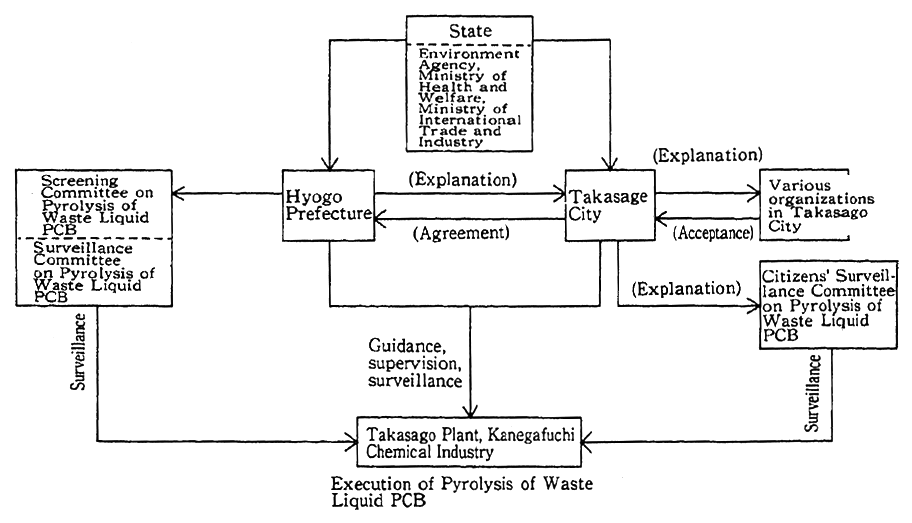
Source: Environment Agency
As for PCB-containing electrical equipment, 335,300 condensers and 33,000 transformers are used and kept at 136,600 business establish- ments across the nation, according to the ledger of the Electric Insulator Processing Association. In addition, electric power and other corpora- tions have transformers and condensers in their custody, and the con- densers recovered from household electric appliances are placed under the custody of their makers. According to the survey conducted by the Ministry of Health and Welfare in 1986, 852 tons of sensitized copying paper containing PCB were placed in the custody of the users.
According to the surveys conducted by some local governments, on the other hand, some of the business establishments described as having taking PCB-using electric appliances under their custody report- ed that some equipment was missing or lost. Given this development, there arose strong calls for the maintenance of an appropriate system of custody until the development of a processing system.
As for the processing of PCB, it was stipulated that studies should be made on the processing technology with attention paid to the preven- tion of secondary pollution and guidance given to entrepreneurs on safe processing methods. Nonetheless, partly because agreement could not be secured from residents on the location of processing plants, appropri- ate processing is not under way except in some districts. When it comes to PCB in custody, however, it is desirable to dispose of it in a prompt and appropriate manner so that careless losses may not give rise to pollution. The situation is such that there are strong calls for the State, local governments, entrepreneurs and residents, to cooperate in grap- pling with this problem with a view to realizing safe processing and disposal. From a perspective of the prevention of environmental pollu- tion, there are calls for proper future responses so that PCB in use or under the custody may not newly give rise to pollution.
4-1-8 Measures To Cope with Global Warming
Global Warming is a changein climate especially in the global mean temperature caused by the man-induced increase of CO2 and other greenhouse gases.
According to the report of the Intergovernmental Panel on Climate Change (IPCC), it ds projected that under the business-as-usual scenario the global mean temperature would rise by about PC by 2025 and about 3 degree C for the end of the 21st century above the present value.
As a result, the global mean sea level would presumably rise by about 20 cm by 2030 and 65 cm by the end of the 21st century. Changes of such an extent has never been experienced by mankind before. The global mean temperature of the earth has changed by about 0.5 degree C in the last 90000 years. Taking 20000 years, this change was exceedingly slow.
There were also eras in which the temperature changed at an extremly fast pace once every 100 year, but the range of this change was not more than 0.5 degree C. Generally, if the Standard deviation is very large than the speed of the temperature change is very slow, and if the speed very fast than the range of the temperature change (Standard deviation) is very small (Fig. 4-1-30). As for the temperature change of the Earth in the next 100 years, however, it is projected that the range and speed will be notably great, and we are to come across unknown environmen- tal changes which have not been experienced in the last 900,000 years. Scenarios have been done for a wide variety of damage, such as the depletion of ecosystems and health hazards, caused by rises in the sea level changes in the water balance and abrupt meteorological phenom- ena.
Fig. 4-1-30 Comparison of Prospective Changes in Temperature and Past Changs in Temperature
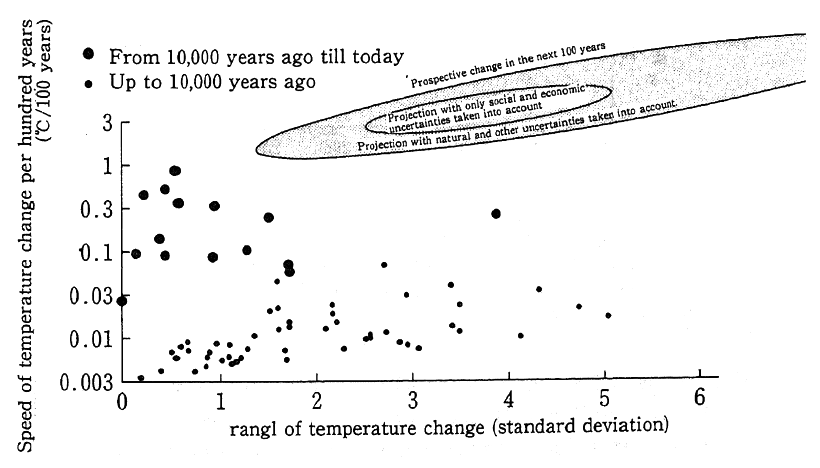
Source: Date from the National Institute for Environmental Studies and Kyoto University
As it is surmised that global warming will produce severe damage in various sectors, it has been internationally agreed to promptly start stepping up measures in the present phase so that damage may not come to the fore. In promoting concrete measures, on the other hand, various problems are posed. In the following, let us see the backdrop against which all sorts of difficulties tend to crop up, the measures to cope with global warming and the direction of measures to overcome them.
(1) Factors Making Measures Against Global Warming Difficult
When it comes to global warming, first, there is a significant time lag between cause and effect; Hence it is still a matter of the futures that the impacts produced by mankind show up. For example, many greenhouse gases have a very' long lifetime in the atmosphere and impacts will be cumulative, as shown in Fig. 4-1-31.
Fig. 4-1-31 Commitment to Sea Level Rise in the Year 2030
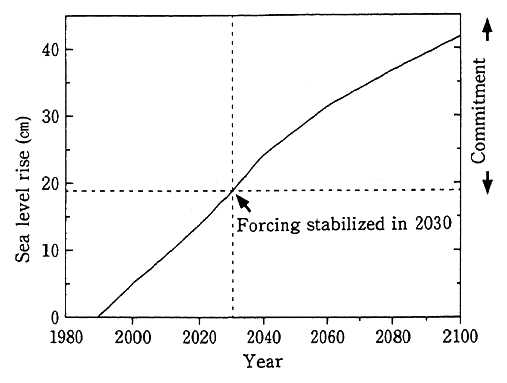
Note: The curve shows the sea level rise due to Business-as-Usual emissions to 2020, with the additional rise that would occur in the remainder of the century even if climate forcing was stabilized in 2030.
Source: IPPC Report
Even if as it has been assumed here, greenhouse gas concentra- tions are to be stabilized at the present levels, there will still be a temperature increase due to the time-delay, which is requirye for signifi- cant changes in the Earth's systems or in the reaction of the nature. For these reasons, it is expected that the rise of the global sea level will more belatedly come. The present generation makes free use of environ- mental resources in pursuit of economic gains But this approach might be described as pre-empting benefits of the future generation.
The temporal gap of global warming in terms of impacts along with the complexity of the System dynamics makes the arising prob- lems difficult to solve. On measures including the development and dissemination of technology, the gap also makes it difficult to agree upon on what measures ought to be taken.
Carbon dioxide emissions are deeply tied in with the utilization of energy, so that it is closely associated with the way economic society ought to be. In a study by the National Institute for Environmental Studies, it is reported that carbon dioxide emissions are insignificant in compact cities whose population density is high. However this study assumes that, the scale of population of these cities is identical and in situations that they are appropriately dispersed on the national land instead of being concentrated (Fig. 4-1-32 and Fig. 4-1-33).
Fig. 4-1-32 Relations Between Urban Concentrations and Carbon Dioxide Emissions
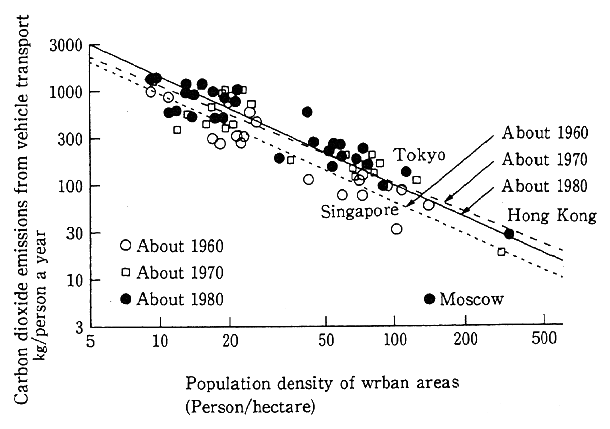
Source : National Institute for Environmental Studies
Fig. 4-1-33 Relations Between Degree of Dispersion of Urban Spatial Location and Carbon Dioxide Emissions
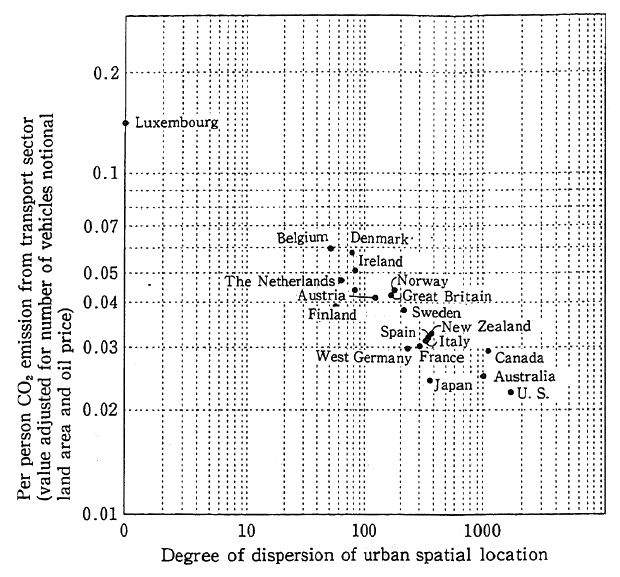
Source: National Institute for Environmental Studies
Furthermore, there is the difficulty of asking persons with differ- ent interests and in different positions to involve themselves in develop- ing measures. As we have just seen, carbon dioxide is something which is broadly generated in economic activities and everyday life so that the scope of subjects on which measures are to be meted out is so exceeding- ly broad.
In particular, warming comes out in a global dimension so that it is necessary to carry out measures in a global dimension too. Given this factor, there is the need for the involvement of all countries around the world, although their interests and positions are different. Then there is yet another question: some countries in the world cannot put effective measures into force in terms of technology, cost and so forth.
(2) Development of International Framework for Measures Against Global Warming and Future Problems
In the participation of the countries around the world concerning the development of the International Framework for measures against Global Warming and future problems there was much progress in 1992. The United Nations Framework Convention on Climate Change, which isgoing to become an international framework to cope with issues on climate change has been adopted. Organized by the U. N. Secretariat in response to a resolution adopted by the U. N. General Assembly in December 1990, diplomatic talks on the Convention began in February 1991. At the Earth Summit, it was passed around for signatures and 155 countries including Japan signed it. It is expected that many other countries will also sign it in the future.
At the talks, debates were hold on differences among countries in interests and positions of that kind to which we have referred earlier. First, arguments about responsibilities for global warming unfolded between developed and developing countries. Whereas developing coun- tries asserted that developed countries are accountable for most green- house gas emissions, developed countries stressed common responsibil- ities, arguing that certain amounts of carbon dioxide were also coming from developing countries. As a result, common but graded responsibil- ities and the leading role of developed countries were provided for in the Convention on the basis of the views of North and South.
When it comes to the setting of a common target by developed countries to curb carbon dioxide emissions, EC nations, Japan and other countries argued that it should be made a common target to stabilize emissions by the year 2000 at 1990 levels. However, the United States raised objections reasoning that the scientific findings are uncertain and the amounts of monly required for measures are enormous. Reflecting such a divergence of opinion, it was stipulated in the Convention that ANNEX I parties to the Convention should adopt measures to alleviate climate change, such as with curbs on greenhouse emissions, take steps in line with them and present information about those policies and measures to the conference of parties within half a year after coming into force.
As for as funding in aid is concerned, developing countries argued for the establishment of a new fund in light of the need for new and additional money with compulsory contributions from developed coun- tries, on the other hand developed countries asserted, that the Global Environmental Facility (GEF), managed by the World Bank, the U. N. Environmental Program and the U. N. Development Program should be made the Convention's funding mechanism. A modus vivendi came out, as it was expressly written that the funding mechanism of the Conven- tion would be temporarily commissioned to the GEF. Whether the GEF would be continuously used was to be decided at the first conference of parties to the Convention. In addition, it was decided, among other things, that the parties to that conference would prepare an inventory of their emissions and removels and inform the conference of parties about it, that they would step up the development and so forth of the curb, reduction and prevention of greenhouse gases and render cooperation in those efforts. Futhermore decided was, that they would promote the management, conservation and so on of greenhouse gas sinks sources and so forth and render cooperation in their efforts. Fig. 4-1-34 illus- trates how the Convention works out.
Fig. 4-1-34 Outline of Framework Convention on Climate Change
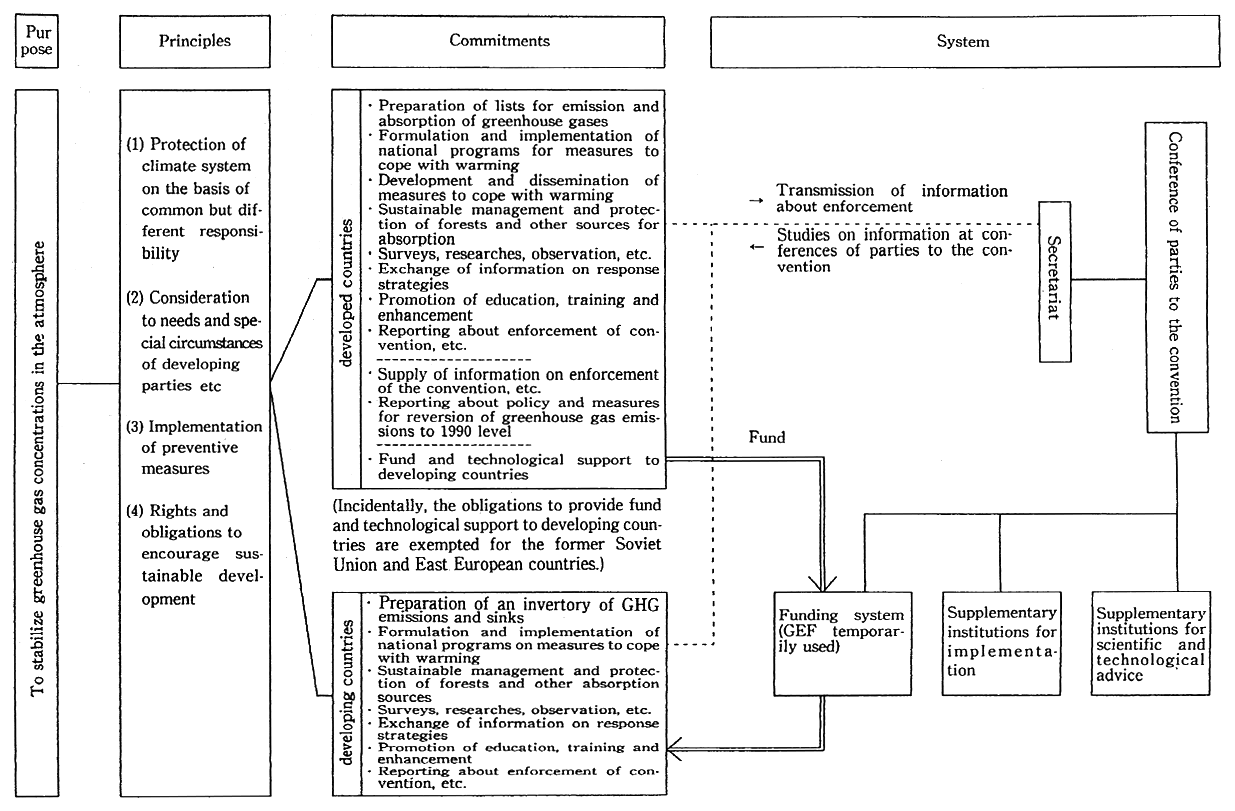
Source: Surveyed by the Environment Agency
Thus, there was a strained debate between countries, but it is worthy of special note in comparison with earlier talks on a convention about the global environment that the Framework Convention on Climate Change was adopted (Fig. 4-1-35). As a reason for it, it may be pointed out that each country of the world had agreed on the importance of ultimately stabilizing greenhouse concentrations in the atmosphere. The Convention is to go into effect 90 days after an instrument of ratification is presented, and the first conference of parties to the convention will be held within one year after. As of March 31, an instrument of ratification has been filed by a total of 17 countries, including Mauritius and 13 other developing countries and three devel- oped countries--the United States, Canada and Australia. Incidentally, a Cabinet decision was made in Japan in March 1993 to call on the Diet to approve Japan becoming a party to the Framework Convention on Climate Change.
Fig. 4-1-35 Examples of Process Leading to Conclusion of Environment-Related Conventions
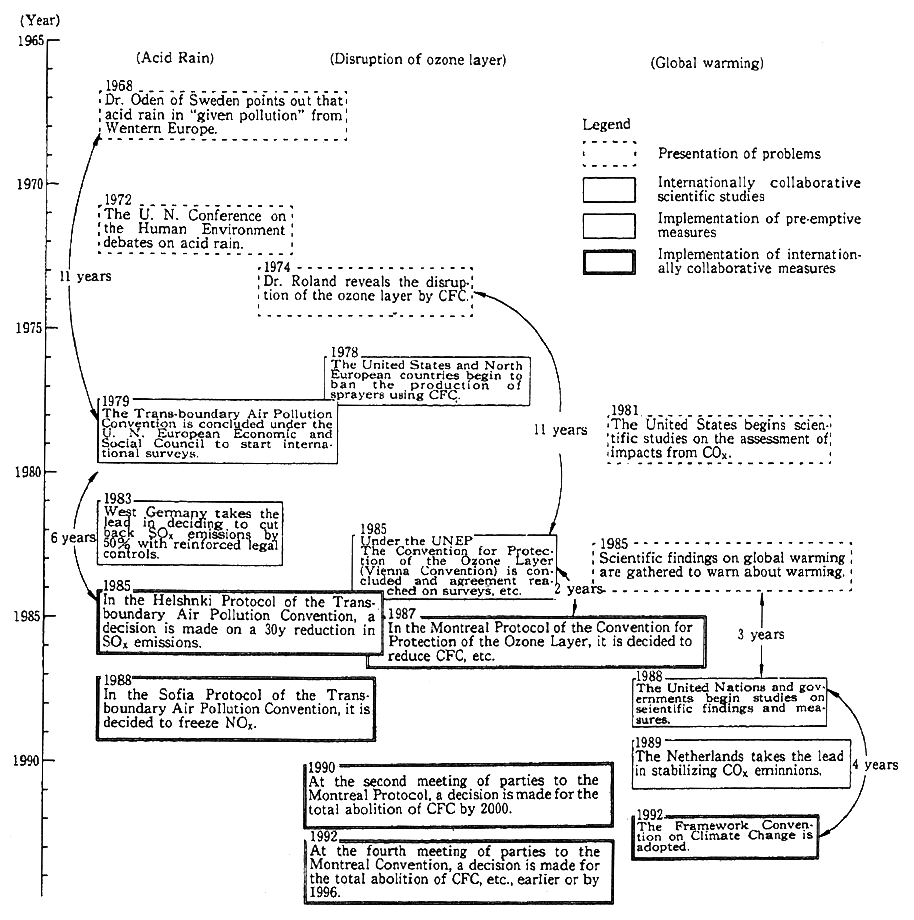
Note: Data from the Environment Agency
In the future, it is important to call on countries to ratify the Convention in order to promptly put it into effect. On the basis of a broad range of international accord on the prompt start of the Conven- tion, it is important to make preparations before the Convention is coming into force for the wide variety of items which will be required for its implementation. For example, it is necessary to start projects in association with the formation of policy and measures on the basis of the Convention and projections on possible effects, and for each country of the world to grapple with a replenishment and improvement of the GEF.
(3) Nations' Trends in Measures To Cope With Global Warming
In the following, let us see how other developed nations work for the prevention of global warming.
a. World's Carbon Dioxide Emissions
Fig. 4-4-36 CO2 emissions for selected groups of countries from 1950 to 1989
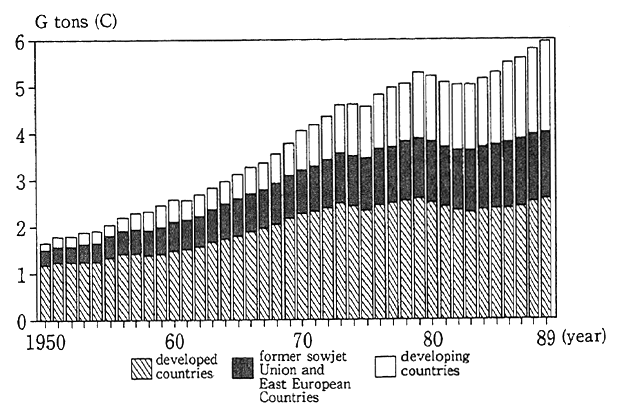
Source: Carbon Dixoide Information Center (CDIAC)
The world's carbon dioxide emissions are projected at 5,970 million tons (in terms of carbon) a year, as shown in Fig. 4-1-36. Developed countries share one half, whereas the other half comes from developing countries and the former Socialist countries including the Soviet Union. A check of trends in carbon dioxide emissions in 1971 to 1989 reveals that the rises in the United States, Japan and other devel- oped countries were minus or increased at an annual rate only of about 1%, whereas both developing countries, and the former Soviet Union and Eastern European countries registered all-round rises. Therefore, when emission increases in recent years are taken up alone, the share of the developing world is significant, and the developing world, the former Soviet Union and East European countries account for more than 80% of the increases. But when it comes to the per capita carbon dioxide emission, it is only about 0.4 ton (in terms of carbon) in the developing world as against 3.3 tons or so in the developed world and about 3.5 tons in the Soviet Union and East European countries, indicating the exis- tence of much difference (Fig. 4-1-37). It is projected that population will keep increasing, primarily in the developing world, and its economies will develop. Unless effective measures are taken, carbon dioxide emissions will inevitably increase to a significant extent. Therefore, it is an urgent task to curb emissions in developing countries, while developed countries with a significant emission per person take the lead in stepping up emissions reductions.
Fig. 4-1-37 Per persons CO2 emissions for selected groups of countries from 1950 to 1989
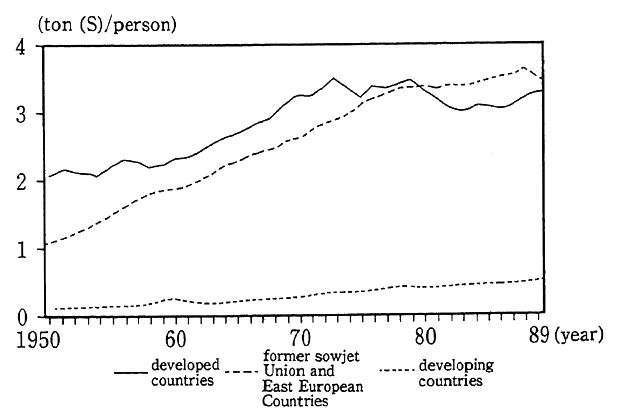
Source: Carbon Dioxide Information Analysis Center(CDIAH)
b. Trends in Developing Countries' Measures Against Global Warming
In Europe, the EC Joint Governing Council of Environment and Energy Ministers met in October 1990 to approve a policy of stabilizing carbon dioxide emissions in 2000 at the 1990 levels as a target. The EC Commission, the EC's executive body, has formulated a strategy of stabilizing emissions, taking up as its centerpieces the various measures formulated by member countries for the production and consumption of energy and the introduction of common EC taxes on energy (Fig. 4-1-38). Various views are being set forth in the EC over the carbon and energy taxes and studies are under way at a political level.
Fig. 4-1-38 Prospective Reductions in Emissions in EC by Sector
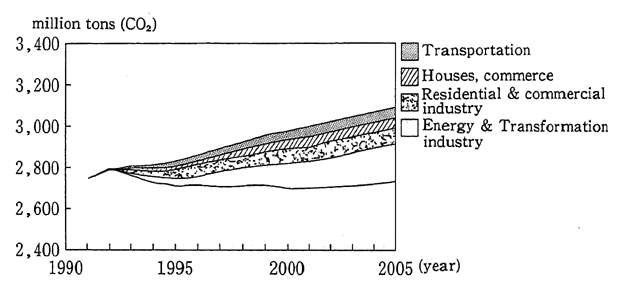
Source: EC data
Given these developments, the Netherlands is promoting a broad variety of measures. The Government of the Netherlands formulated a National Environmental Policy Program in 1989-90. Under this pro- gram, it is broadly promoting policy measures to contribute to reduc- tions in carbon dioxide emissions and other policy measures to curb greenhouse gases and their precursory substances, such as by designat- ing carbon dioxide emissions in 1989-90 as standards, stabilizing emis- sions at the standard years' levels by 1995 and introducing the same carbon and energy taxes as under study by the EC.
All these measures are taken with view to working for a 3-5% reduction by 2000.
On the basis of a status report submitted by the lnterministrial Task Force on CO2 Reduction in 1990, Germany decided to reduce the CO2 emissions by 25-30% by 2005 based on the emission level of 1987. For realization of this target, it is carrying out a broad range of measures.
The European Free Trade Association (EFTA), whose members center on North European nations, expressed a policy of stabilizing emissions at the 1990 levels by 2000 at the second World Climate Conference. Many EFTA nations have introduced a carbon tax to cut back carbon dioxide emissions. Sweden, an EFTA member which came out earlier than any other member in introducing the tax, is considering a wide variety of measures to curb carbon dioxide emissions. Sweden also projects that reductions in carbon dioxide emissions would come to 5-10 million tons by 1999, or about 8-16% of the emission level in 1991.
In the United States, President George Bush's Republican admin- istration was taken over by a new administration under President Bill Clinton in January 1993. As suggested by the prompt establishment of an Office of Environmental Policy in the White House, the new administra- tion is expected to take more significant steps in regard to global warming.
The targets for measures by developed countries to cope with global warming shown in Table 4-1-10.
Table 4-1-10 Developments in Each Country for Setting of Greenhouse Gas Targets
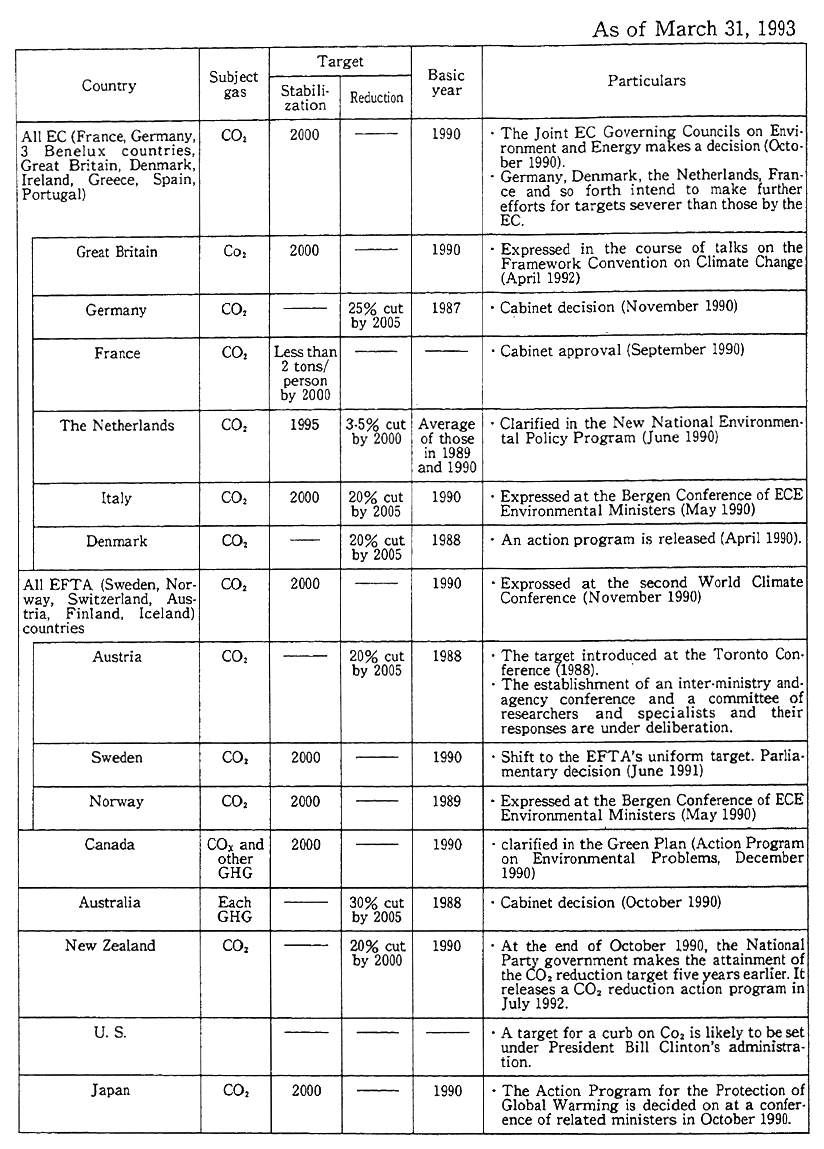
Source : Data from the Environment Agency
In addition, the OECD is making studies for implementation of the Framework Convention on Climate Change close collaboration the IPCC and other institutions. The OECD is also making surveys and studies on the further effective use of a wide variety of economic measures.
(4) Japan's Measures To Cope With Global Warming
a. Implementation of Global Warming Prevention Action Program
As we have mentioned, it is important to come out with a consensus on measures with an eye towards future prospects, and to develop and disseminate technology. In this light, it will be important to make targets clear and to work out a framework for promoting a broad range of measures in an integrated and steady manner, to graphically enumerate various measures for their realization and formulate a program in which the expected roles of related persons are clearly described.
In Japan the Council of Ministers for Global Environment Conver- sation established the Action Program TO Arrest Global Warming in October 1990 in response to the remarks Prime Minister Toshiki Kaifu made at the Houston Summit early that year. The program is designed to shed light on the whole range of government policies for promoting the systematic and integrated promotion of measures to cope with global warming. It is also designed to cast light on the formation of an international framework.
The program makes clear the basic notion that there is the need to step up measures which can immediately be translated into action in collaboration with other countries of the world. The Basic Elements to be taken into account for promotion of measures to cope with global warming are the Formation of an environmentally-sound society, the compatibility with Economy's Stable Development and the lnternational Coordination.
For accomplishment of the targets, which aim a stabilization of the per capita CO2 emission and the total amount of CO2 emissions at the 1990 level in 2000, the goal is to start promoting the wide variety of measures incorporated in the program, in view of the possibility of the revolutionary development of technology allowing for greater strides than projected at present.
The program incorporates a broad variety of measures, and those which are under way include the greening of cities, such as the develop- ment of parks to alleviate the heat island phenomenon, and public works of the kind which will contribute to the prevention of warming, such as the development of infrastructure for public transportation with rela- tively less carbon dioxide emissions. Attempts are also being made for the saving of energy at public facilities and for having postal services and local governments take the lead in the utilization of less-polluting vehicles.
For the streamlining of institutions, on the other hand, the Law for Promotion of the Utilization of Recyclable Resources was enacted in October 1992, which, among other things, obligates entrepreneurs to recycle paper, cans for drinks and so on. In May 1993, the Law for Rationalization of Energy Utilization was drastically amended with a new provision under which the State's basic policy would be to rational- ize energy utilization and to strengthen measures for the acceleration of entrepreneurs'energy-saving measures. Before the amendment of this law, attempts were made in August 1991, February 1992 and January 1993 to upgrade the performance of insulation materials and the fuel efficiency of autos. To support private entrepreneurs' voluntary energy- saving, recycling and other projects and activities, among others, the Law of Provisional Measures for Projects and Activities to Rationalize Use of Energy, Etc., and Utilize Recycled Resources was promulgated in March 1993.
As grant-in-aid measures, support is given, such as loans from government-affiliated institutions and tax preferential measures for the installation of power sources for the dispersion of solar rays and so forth, insulation facilities, energy-saving building facilities, cogenera- tion and combined-cycled power generation. In addition, a wide variety of measures are in force to curb carbon dioxide emissions, such as measures to develop and utilize atomic power on the condition of assured safety.
Moreover, measures are taken to curb methane and other green- house gas emissions, to absorbe carbon dioxide, such as by forest conservation. Also measures are taken in the sectors where observation and surveillance are promoted and where technology is developed, disseminated and enhanced are included.
International cooperation is being rendered by making effective use of technology and know-how of Japan's environmental conservation, such as support to the development of human resources in developing countries and the transfer of technologies fitted to counterpart coun- tries, and the promotion of international research, such as by the National Institute for Environmental Studies, so that all countries around the world may advance together in working for protection of the global environment.
b. Trends in Carbon Dioxide Emissions
According to a trial calculation of the Environment Agency, total CO2 emission amounted ot 324 Mio. tons in fiscal 1991 (Fig. 4-1-39). On a per capita basis, this indicates emission of about 2.61 tons. In compari- son with the emission in the basic year 1990, 318 Mio. tons and 2.57 tons per capita, the total emission in creased by 1.9% and also the per capita emission increased by about 1.5%.
Fig. 4-1-39 Carbon Dioxide Emissions in Japan (in terms of carbon in 1991)
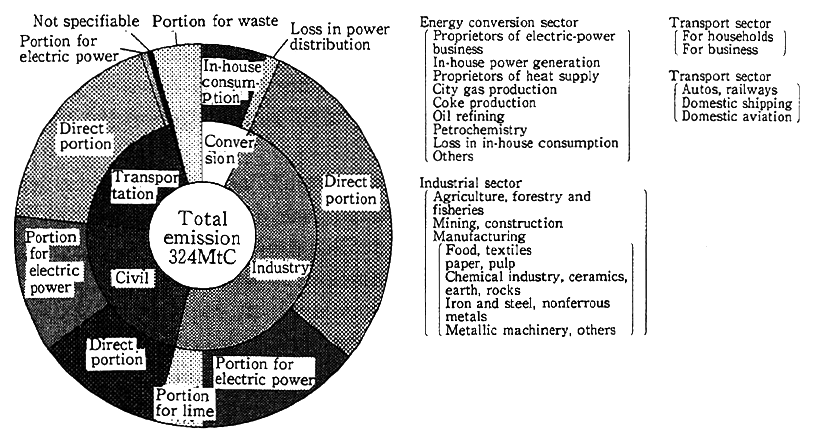
Source: Computed on a trial basis by the Environment Agency on the basis of the Comprehensive Energy Statistics, etc.
Note:1. Emissions are expressed in terms of carbon. Multiply them by 3.67 for conversion into the mass of carbon dioxide.
2. The total emission does not include that of 9.0 MtC of bunker oil.
Looking at the sector-specific emissions, following picture is given: In the industrial sector there had been signs of increase generally since the mid-1980s until fiscal 1991, when emissions leveled of in the entire sector. In terms of comprehensive energy statistics, the unit energy consumption per value of output in the manufacturing industry had been dropped since the first oil crunch 1973 until fiscal 1991, but has worsened for the first time up 1.5% from the preceding fiscal year.
In the transport sector, there had continuously been signs of a rise, coming to 2.6 million tons in fiscal 1991, up 4.5% from the previous fiscal year, suggesting this rise was higher than the rise in the volume of transport (up 2.5% from the preceding fiscal year). In the public welfare sector, there have been signs of a rise in recent years and increases have been observed in the household and corporate sectors. Carbon dioxide emissions in this sector in fiscal 1991 were 2.5 million tons greater than in the previous fiscal year.
(5) Toward Further Cooperation in Striving to Solve Question of Global Warming
As we have just seen, carbon dioxide emissions in Japan in- creased in fiscal 1991 as in the earlier years as a whole. The unit of energy consumption in the manufacturing industry (which had im- proved) began to increase. As is discernible from this phenomenon, there is no denying that the society as a whole has moved toward greater carbon dioxide emissions, during the course of what is generally known as the "bubble economy."
Given this picture, Japan should strive for an early enforcement of the Framework Convention on Climate Change, and work so that the Action Program to Arrest Global Warming may take on a more tan- gible character and secure the involvement of a broad range of entities with greater cooperation.
When it is taken into account that greenhouse gases--above all, carbon dioxide--are tied in with all sorts of socioeconomic perfor- mances and everyday life, it is necessary for all entities to renew their determination to make further efforts. The approaches are broad in range, extending from the utilization of the national land to urban infrastructure, to everyday life behavior. For example, there are calls for coordination in stepping up compulsory approaches to promote inherent strengths and compensate for weaknesses in the process that extends from the phase of heat and energy production to that of final demand by surmounting shortcomings in power generation plants, fac- tories and dwellings (Fig. 4-1-40). Such approaches may be realized only by a review of society and our life styles and by overcoming technologi- cal bottlenecks in specific sectors.
Fig. 4-1-40 Examples of Comprehensive Utilization of Waste Heat Energy (utilization of heat of sewer treatment water in Makuhari, Chiba Prefecture)
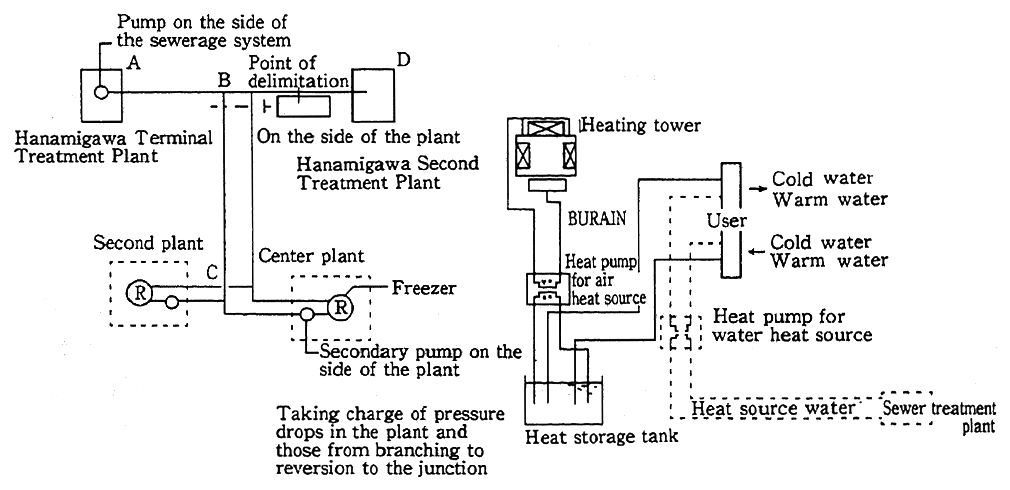
Source: Electric Air-Conditioning Research Group, Air-conditioning by Heat Pumps, No. 35
4-1-9 Developing Countries' Environmental Measures
Today, environmental issues are no longer confined to developing countries but turn out to be of concern to all countries around the world. With the internationalization of economies, raw materials, products, funds and services flow across national borders. Given this phenomenon, economic activities in developed countries affect the environment of developing countries through trade and so forth, whereas environmental disruption and the depletion of resources in developing countries and so on affect the activities of developed countries. Moreover, when it comes to global warming and other issues associated with global environment, it would become difficult to improve the entire world, whatever mea- sures are taken by developed countries alone, unless appropriate mea- sures are also taken by developing countries whose economic activities will increase. In this context, the environmental measures taken by developing countries are of worldwide concern, becoming one of the most important issues at the Earth Summit.
In the White Paper on the Environment for fiscal 1993, an attempt was made to analyze in detail the backdrop for environmental problems in developing countries. Given this analysis, we will take a look at problems and measures to overcome them in the White Paper for this fiscal year.
(1) Environmental Issues in Developing Countries and Workings of Environmental Conservation-related Government Institutions
One of the environmental issues with which developing countries are confronted today, as we have seen in Chapter 1, is nature disruption for which poverty is primarily responsible. For another thing, environ- mental pollution and nature disruption resulting from the rapid expan- sion of economic activities are of importance. As an example, forests are destroyed by poor peasants bringing forests under cultivation. In the latter case, water and air pollution and nature disruption are worsened as environmental measures fail to keep up with industrialization and the rapidly expanding production of agriculture, forestry and fishery prod- ucts.
Table 4-1-11 Status of Legal and Institutional Facilities for Control, Monitoring and Management of Water Quality in the Asian and Pacific Region
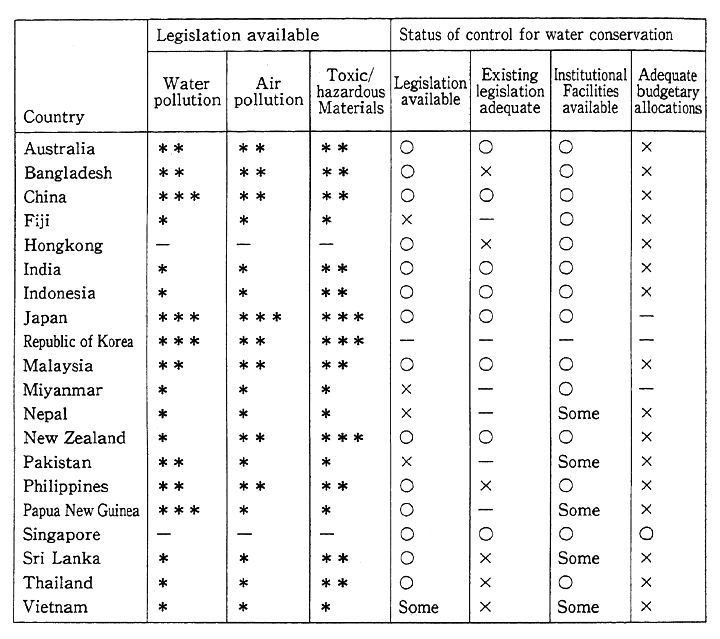
Note: *** Extensive coverage
> : Available
* * Moderate coverage
× : Unavailable
* Minimal coverage
In developing countries, too, the principle is for their governments to serve as the core in promoting environmental measures. Nonetheless, the approaches made by the governments of developing countries to environmental problems are not necessarily adequate. Table 4-1-11 illustrates legal institutions in various environmental sectors of Asia- Pacific nations and their water-related environmental conservation systems and those for implementation. Legal institutions in developing countries in various environmental sectors remain inadequate, but their development is in progress. When it comes to the example of water, the implementation system of legal institutions cannot be described as sufficient in more than half of them, and there are virtually no countries where sufficient budget allocations are made. In order to step up the transfer of environmental technology, it is important as a precondition to carry out transparent, impartial and realistic environmental controls. Viewed in this light, it is necessary for the governments of developing countries to strengthen their ability to implement environmental mea- sures.
Depending on the stances taken by the governments of developing countries, the pattern in which environmental issues are posed is signifi- cantly different. Let us take Singapore and the Republic of Korea as examples and how significant the role played by each government is.
Fig.4-1-41
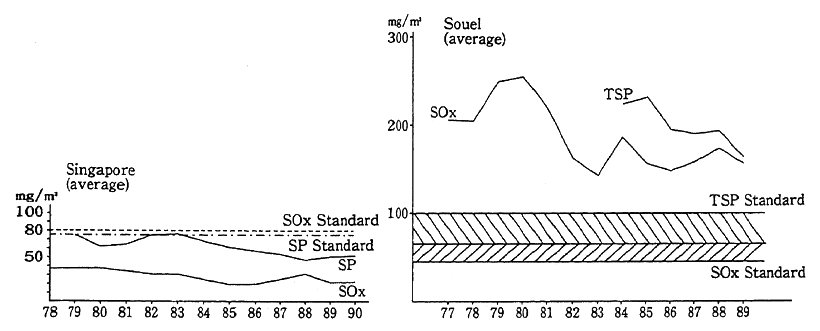
Sources: Ministry of the Environment, Singapore, Annual Report; UNEP/WHO, Urban Air Pollution in Megacities of the World
Departing from the status of developing countries, Singapore and the Republic of Korea are developing faster than any other country. They are actively grappling with environmental issues. But there are some differences in the way of wrestling with environmental issues and the differences are apparent in the conditions of the environment. Fig. 4-1-41 illustrates conditions of air pollution in Singapore and the Repub- lic of Korea. The environmental quality standards have not been surpas- sed in Singapore since 1980, but the Republic of Korea came in as recently as 1991 to satisfy the environmental quality standards. The GNP growth in both countries and how they have taken environmental measures are illustrated in Fig. 4-1-42. With the Environment Ministry established in 1972, Singapore began to grapple with preventive environ- mental measures already in the initial phase of. its economic develop- ment, whereas the environment in the Republic of Korea deteriorated along with its economic development and, while the economic develop- ment slowed down, it was compelled to step up environmental measures. Both countries have stepped up efforts in their respective historical and social conditions, but Singapore might be described as having excelled in this context.
Fig. 4-1-42 GDP Growth Rate and Evolution of Environmental Administration in Singapore and the Republic of Korea
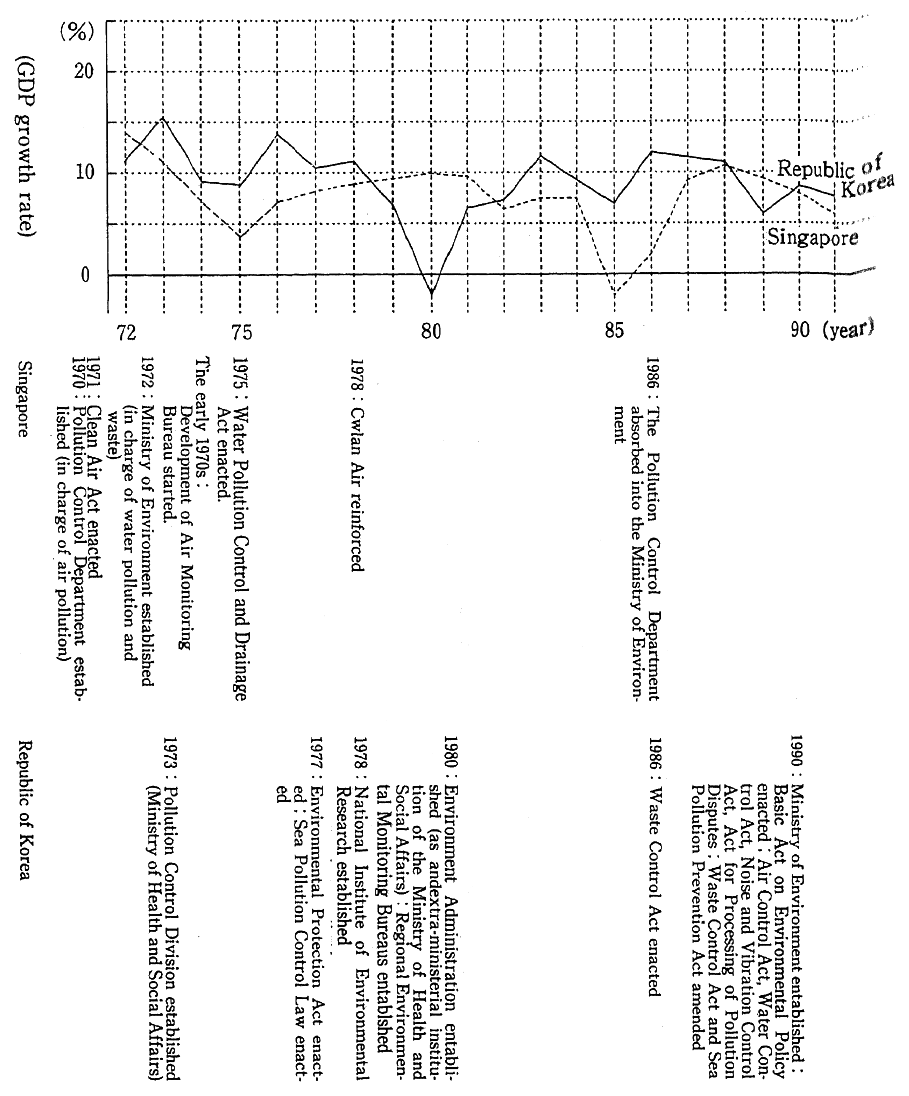
Sources:
Singapore; Singapore's National Report for UNCED Preparatory Committee
Republic of Korea ; Environmental Protection in Korea, 1993
Bank of Japan's Survey and Statistics Bureau et al., Yearbook of Foreign Economic Statistics
Environmental issues are significantly tied in with the conditions of social and economic policies, so that they produce significant impacts on nations' socioeconomic policies.
Poverty is responsible in large measure for the degradation of natural resources in developing countries, such as the depletion and degeneration of forests, soil erosion and desertification. For example, industrialization is not fully in progress, and in countries where the surplus labor force of rural communities is not fully absorbed, poor peasants are closed out of fertile farms. For example, they clear forests on the steep mountain slopes for farming or engage in excessive cultiva- tion at readily arable places, thus giving rise to forest depletion and its ensuing soil erosion and desertification.
The forest depletion of the Philippines is also serious. As one reason, it is pointed out that farms in the forests are expanded with the inflow of poor peasants. Fig. 4-1-43 illustrates the unemployment rate, conditions of highland migration and the rate of farmlands in the forests. Particularly at the beginning of the 1980s or so, migration to highland areas with many forests increased, and as shown in the figure, the rate of farms in the forests rose. As one reason, it is pointed out that peasants could not be fully absorbed into the agricultural sector partly due to the land ownership system, and that the national economy came to a standstill with the advent of the 1980s, thus disabling cities to fully absorb manpower.
Fig. 4-1-43 Unemployment, Population Drift into Upland, Upland Agriculture
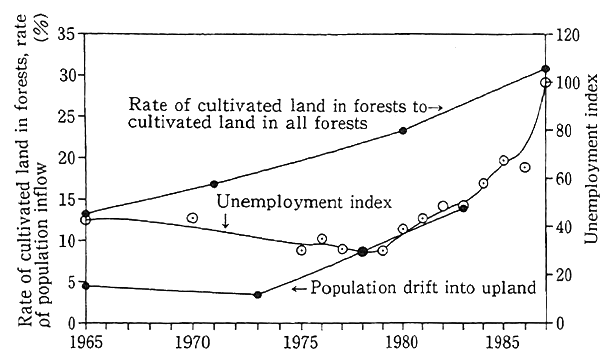
Notes: Rate of cultivated land in forests: NEDA, Philippine Statistical Yearbook (1989); World Bank (1989), Strategic Study Group, RP-German Forestry Resources Inventory (1991)
Population drift into highland: National Census and Statistical Office, Population Census 1970, 1975, 1980 ; Barangay Census, 1985, aijusted for upland by Cruz, Zosa-Federanil and Goce (1986)
Unemployment index : Philippine Statistical Yearbook (1989)
Source: World Resource Research Institute, The Environmental Effects of Stabilization and Structural Adjustment Programs: The Philippine Case, 1992
To prevent the degradation of natural resources, therefore, there are strong calls for the adoption of economic policy which will not give rise to poverty. In managing economic policy, it is important to take account of the environmental impacts of development so that it may not give rise to nature disruption and environmental pollution and step it up in parallel measures to prevent environmental disruption. Considera- tions to the environment with such a variety of policy measures are something which promotes the integration of environmental policy with economic policy on which agreement was reached at the Earth Summit.
To realize such policy integration, not only persons in charge of environmental policy but those in charge of various other policies as well are required to take account of their own country's environment, keep close contact with environmental bureaus and departments and promote policy measures. Here again, an enhancement of the ability of persons associated with the environment is required.
(2) Cooperation in Developing Countries' Human Resources
a. Cooperation With Official Development Assistance
Official development assistance (ODA) is an important means of cooperation in the efforts made by developing countries.
Japan began to step up environmental cooperation on a govern- mental basis in the 1980s, and its scale has rapidly broadened in the recent time. The Council of Ministers Related to Conservation of the Global Environment in June 1989 agreed to strive for the enhancement of official development assistance, the development and transfer of technology compatible with the conditions of developing countries and the development of human resources in the environmental sector, among other things. At the Earth Summit, Japan expressed its intention of striving for a significant expansion and replenishment of aid in the environmental sector for five years from fiscal 1992 with a view to bringing it from ¥900 billion to ¥1 trillion. Cooperation in the environ- mental sector is bearing fruit, and achievements have come out of many projects.
Let us see how Japan's forestry cooperation rendered at Lake Pantabangan in the Philippines since 1976 is assessed. In this project, afforestation, the development of reclamation technology and technical guidance were made along the upper reaches of the Pantabangan, where grassland was stripped and earth and sand were likely to be washed out by slash-and-burn cultivation and exploitative pasture reproduction, so that forest management, anti-flood afforestation and social forestry could be conducted (Fig. 4-1-44). From Japan, 53 specialists on longtime assignment and 91 on short-term duty were sent to the Pantabangan. Japan also offered equipment and materials and bore part of the local expenditure. With cooperation rendered for 16 years, about 8,000 hoc- tares of forests were developed. In addition, efforts were concentrated on the development of human resources, and 46 Filipinos were trained in Japan and another 629 in the Philippines. High hopes are pinned on their activities in the future. According to the report prepared at the end of the project, this cooperation project was highly rated both by the Philippines and Japan.
Fig. 4-1-44 Location of Forest Development Projects in Pantabangan
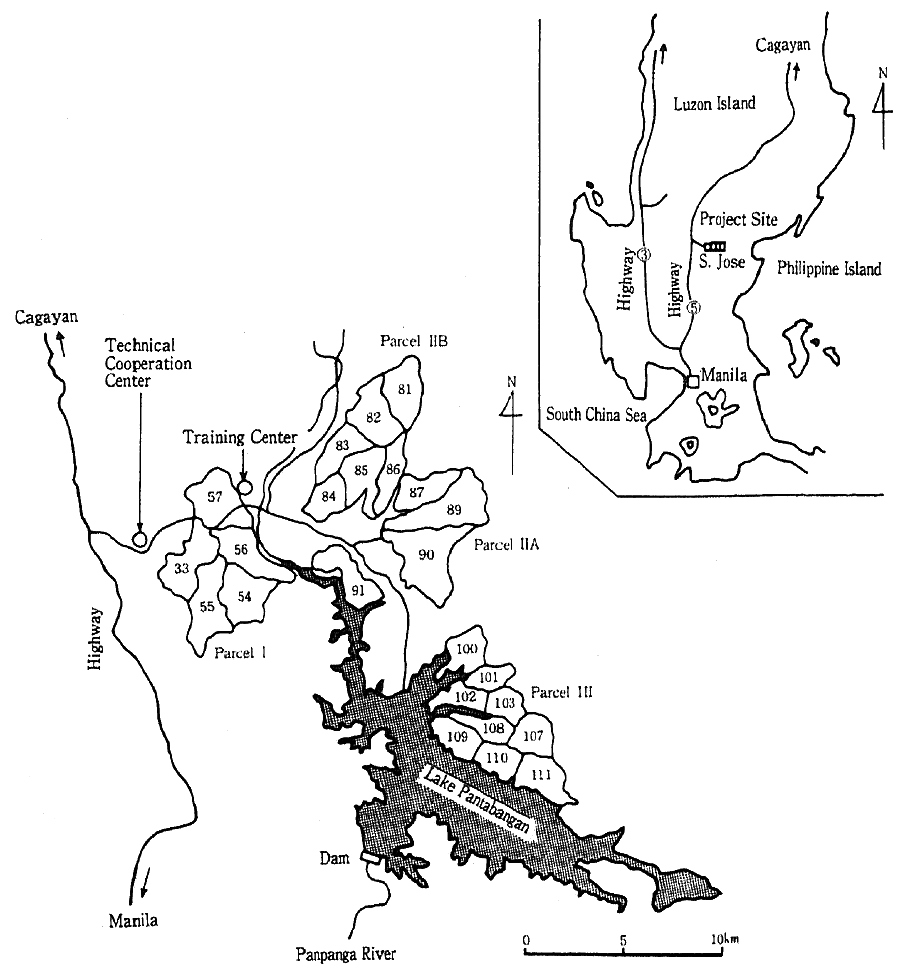
Source: JICA, Integrated Philippines-Japan Forestry Development Project, 1992
On the other hand, this project provided many lessons as the first of its kind. One merit was to provide local residents with a sense of responsibility for forest management and with incentives. As some of the experimental forests are lost by "forest fires." What are described as "forest fires" here are caused by the development of upland fields in the national forests, the setting of fire to meadows and its spreading. Local residents are more interested in turning forests into farms and so forth to have access to food and incomes than in maintaining forests as they are, with the consequence that fire affects invaluable forest areas and or that forests are lost due to a fire spread. Local residents have yet to be fully aware that the existence of forests provides them with various benefits and that if forests are lost, impacts on their lives, such as disaster will be bigger in scale. The backdrop for this is that solutions have yet to be found for poverty in which there is no choice but to move into forests to gather something to eat and about the system of land ownership. In this project, too, those questions are grappled with in an early phase, and social forestry in which the development of forests (some farm produce are also cultivated), the involvement of local residents, fire prevention movements with their participation, afforesta- tion festivals and the distribution of brochures, among others, are performed, thus enhancing the importance of forests and improving the socioeconomic conditions of highland residents. Though achievements are made to some extent, it is expected that the experiences will be put to full use.
To make cooperation a success, it is pointed out in some assess- ments that there is the need to work out measures not only in the scientific and technological sectors but those in the economic and social sectors, such as local conditions and the conditions of stock-farms.
The most important problem for the extension of environmental cooperation is to see to it that aid-receiving countries may establish themselves and manage the environment. For this, it is necessary, first, to survey the local natural, social and economic conditions, instead of being content merely with the offer of technology, equipment and materials. With this in mind, it is also necessary to take necessary measures and realize more elaborate and professional cooperation, such as by enhancing the understanding of local inhabitants and encouraging developing countries to train personnel and develop institutions so that they can wrestle with environmental management by themselves.